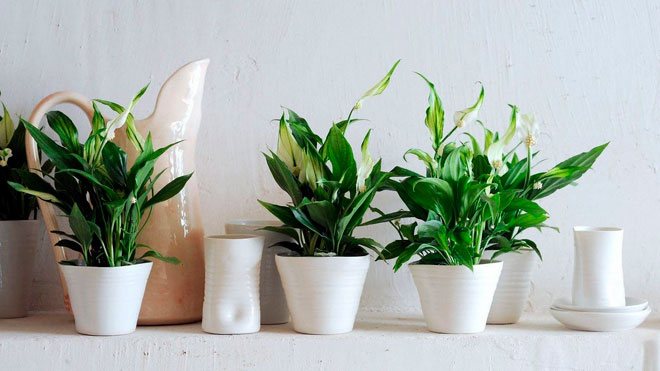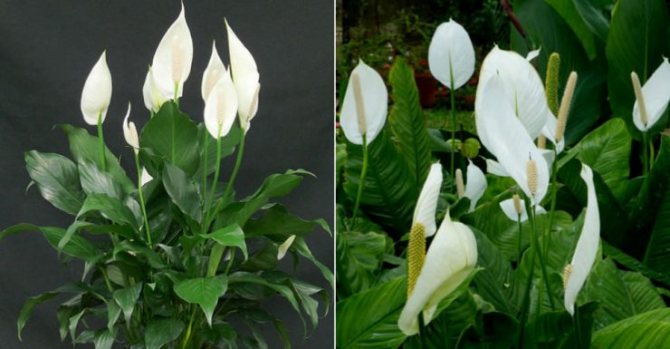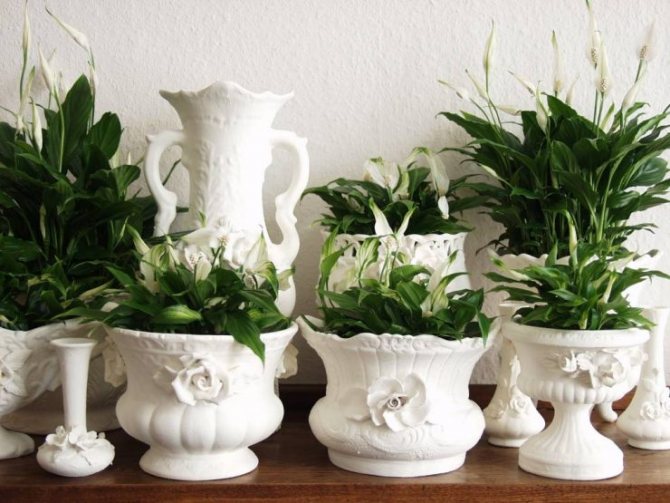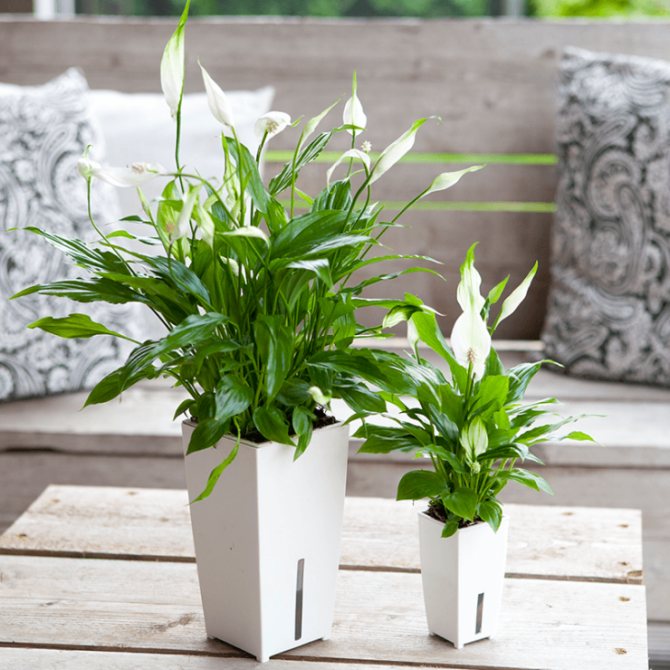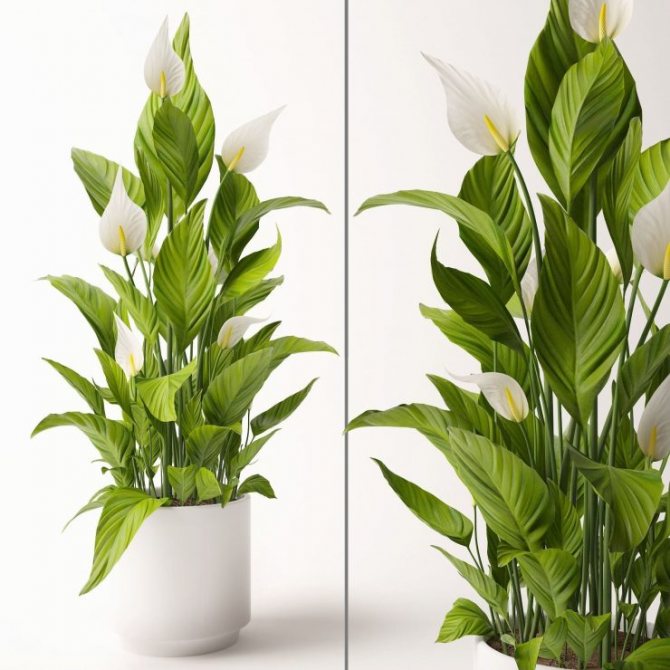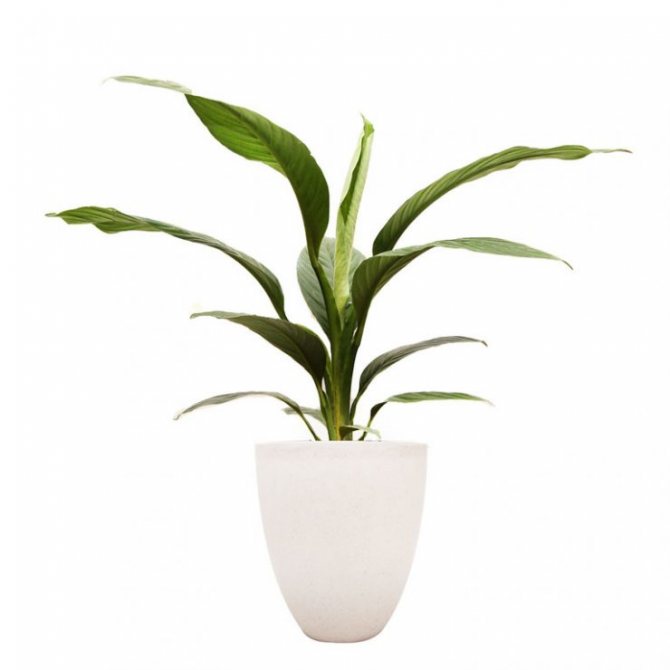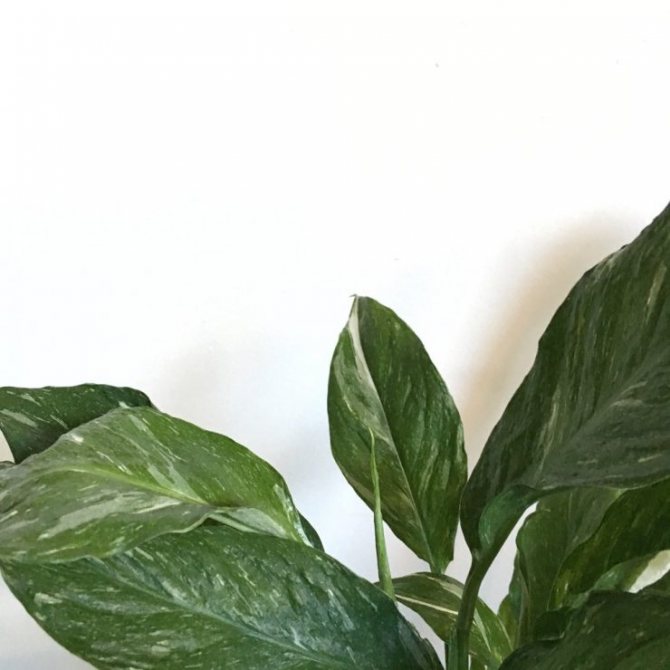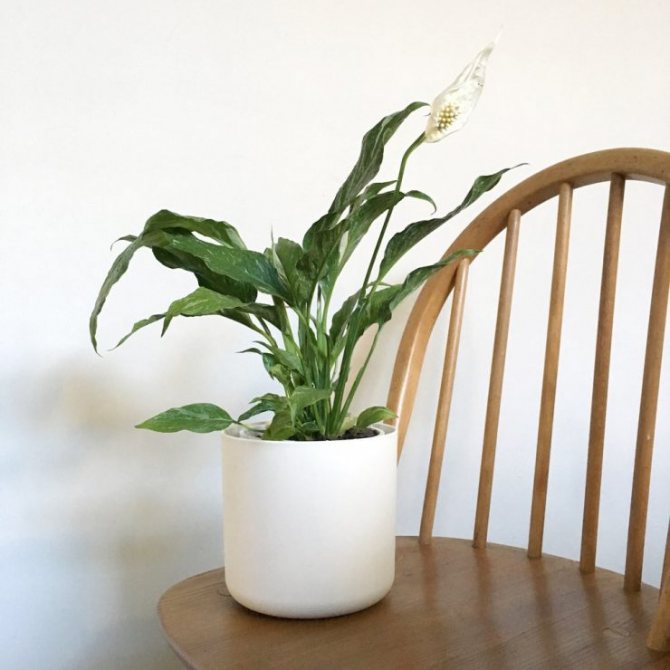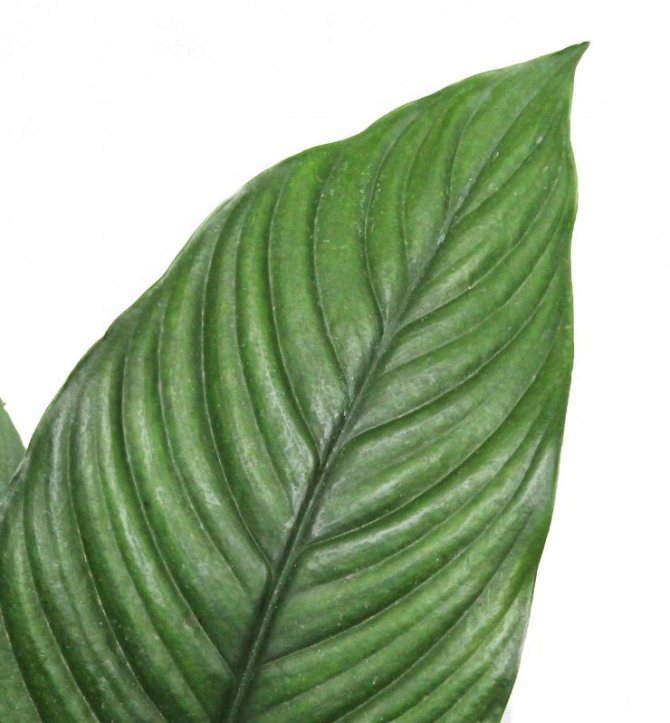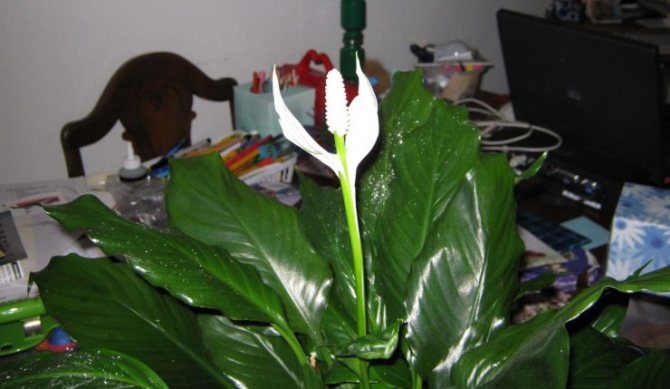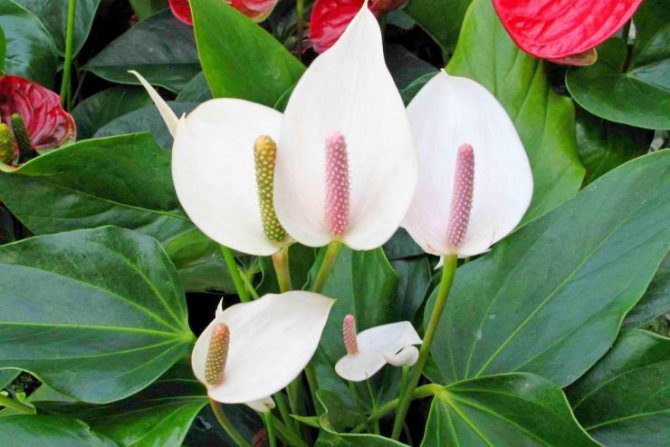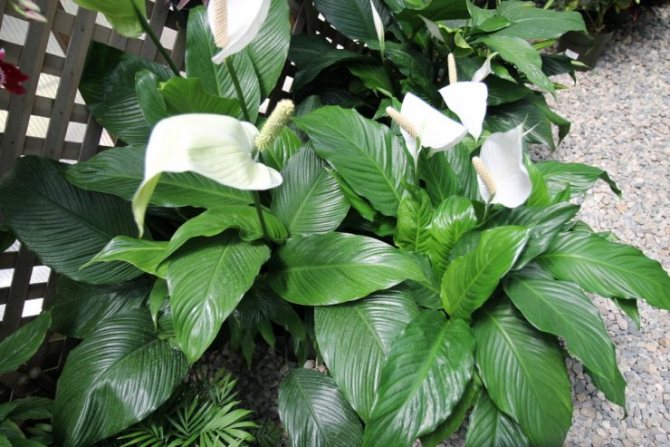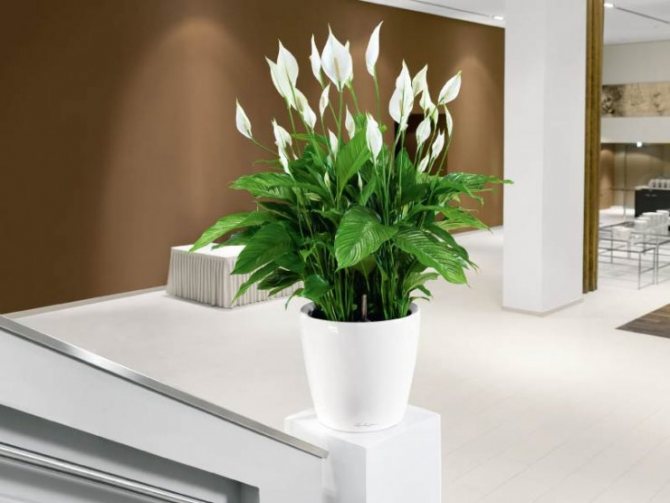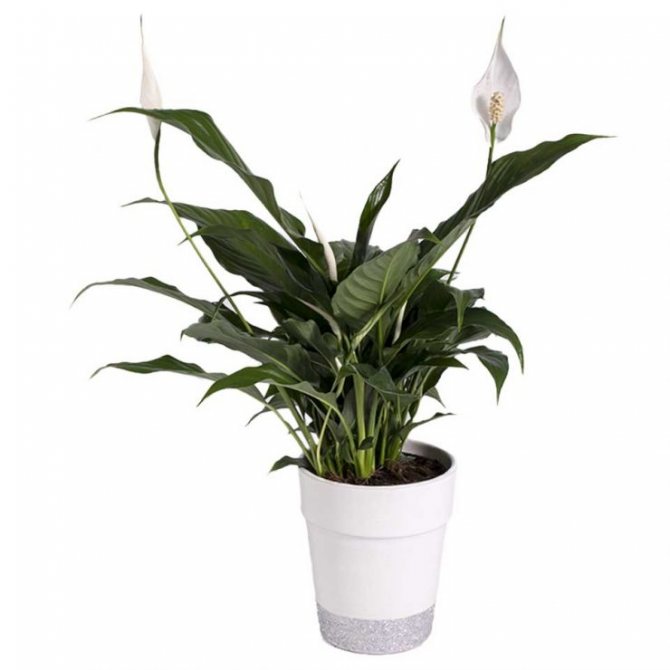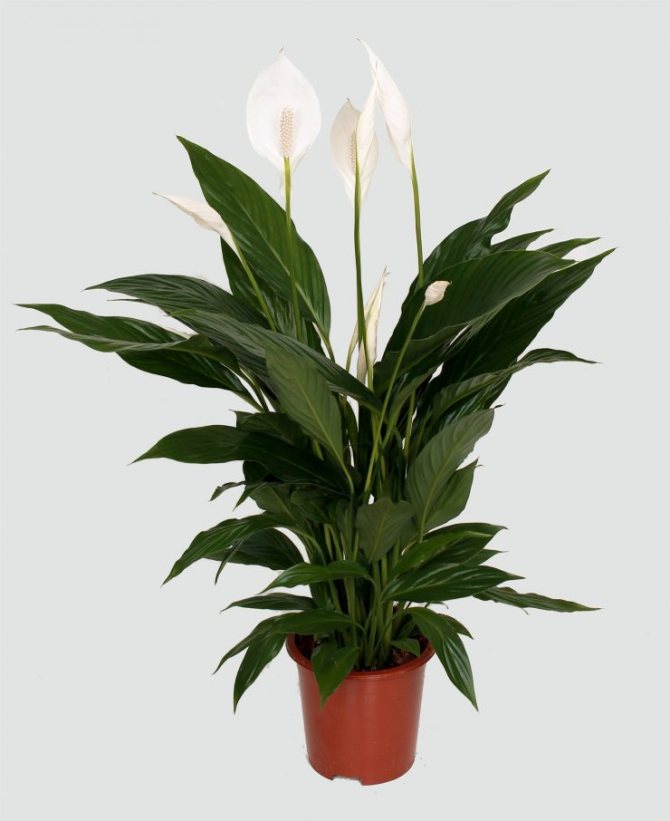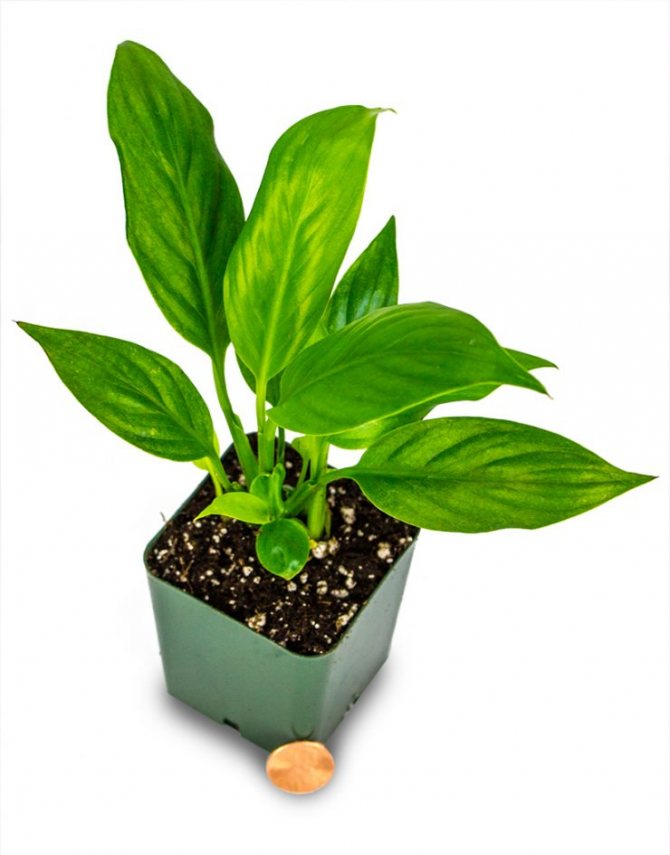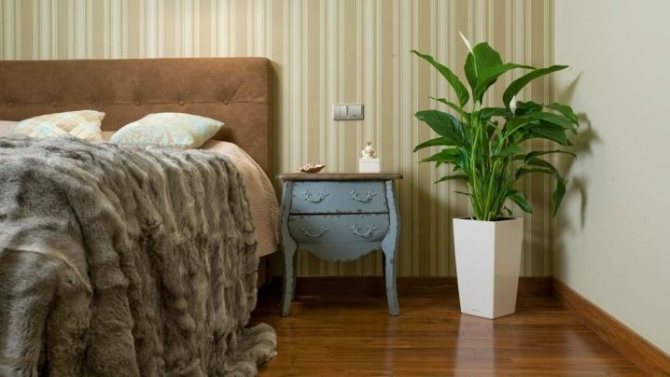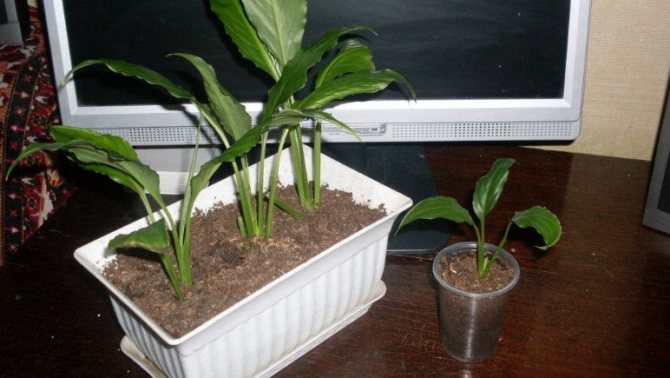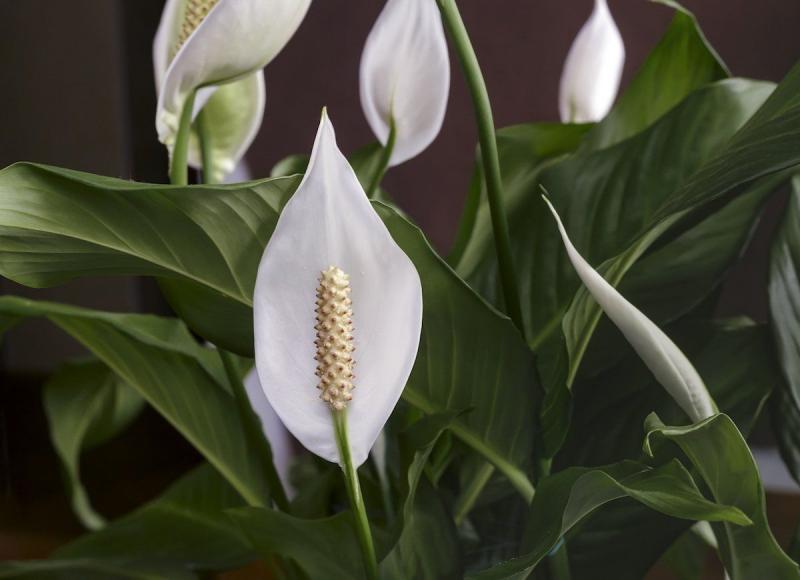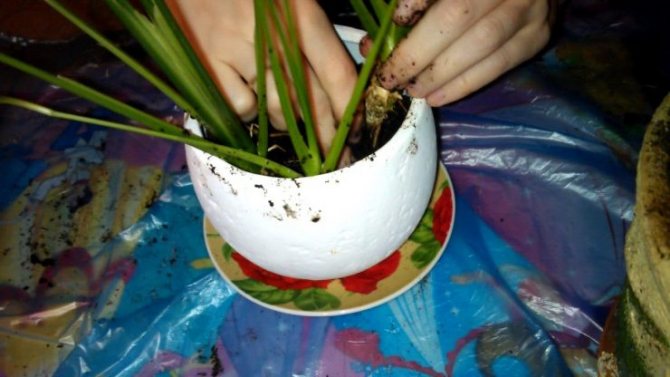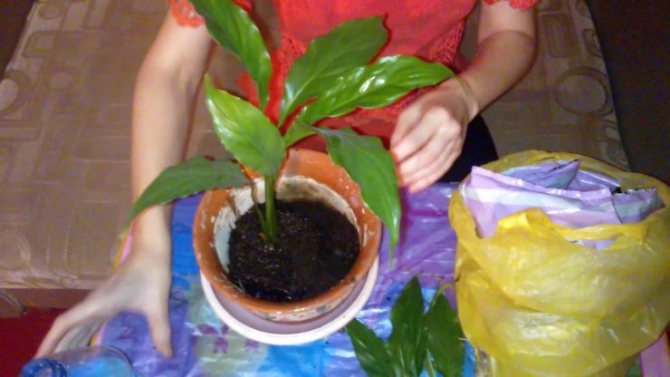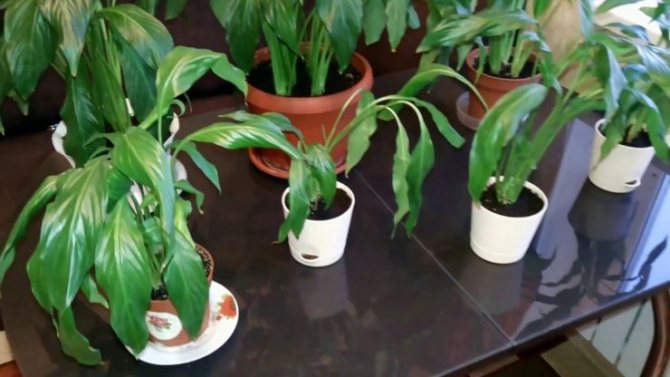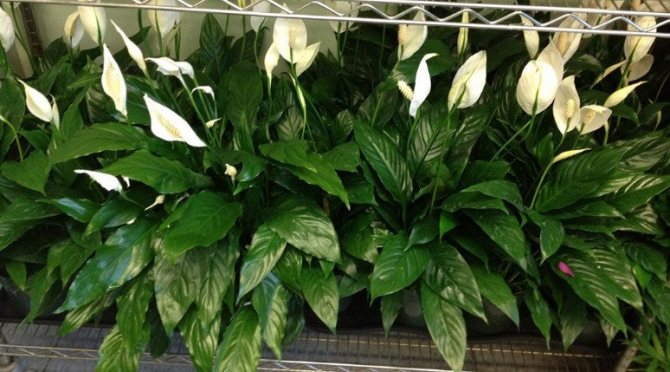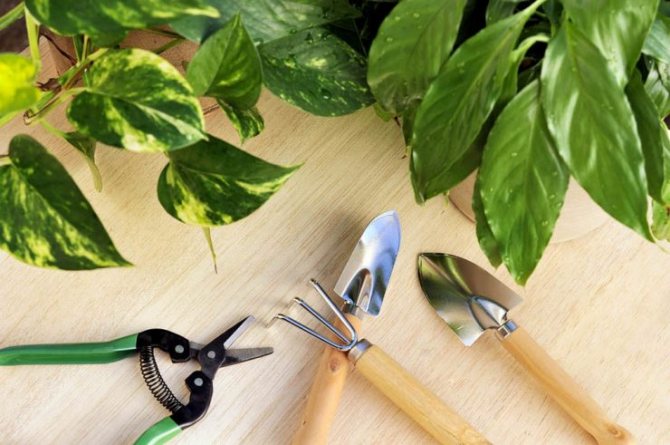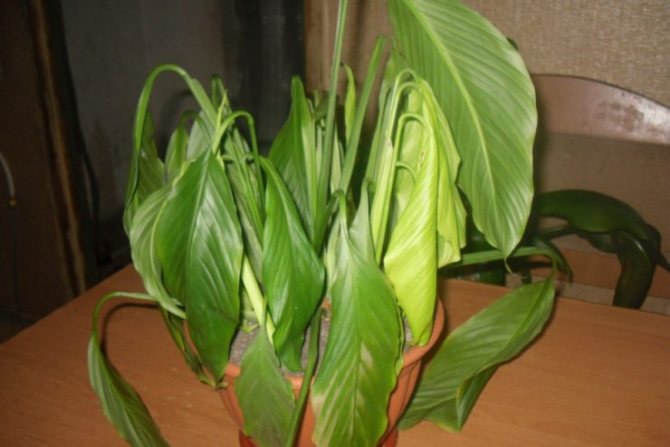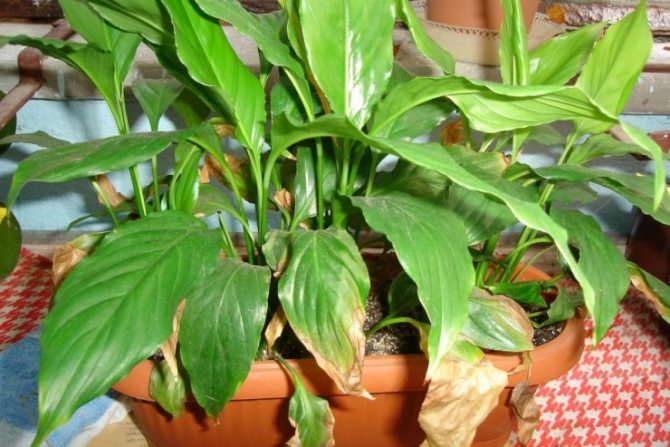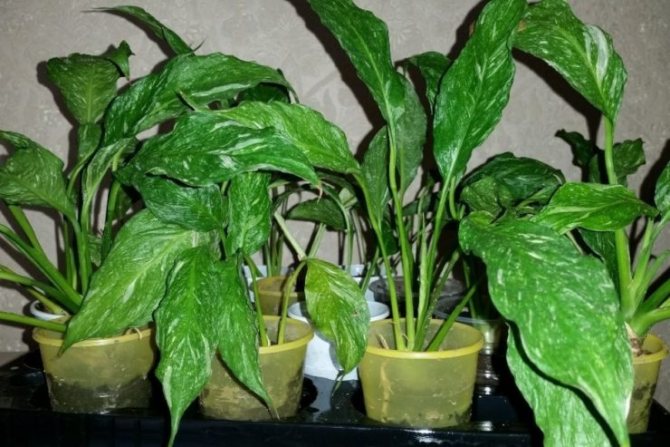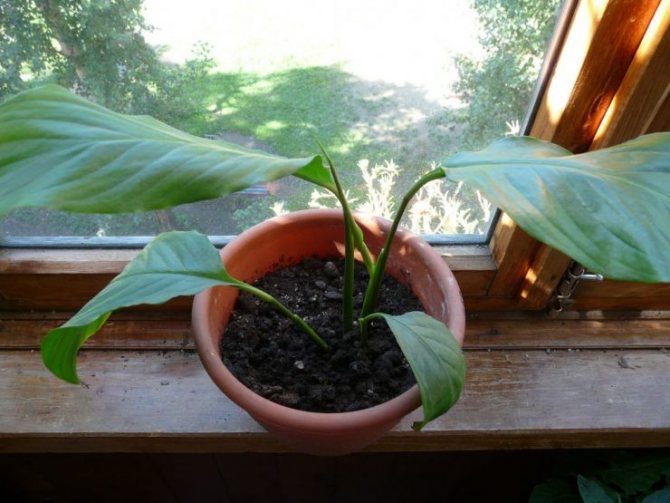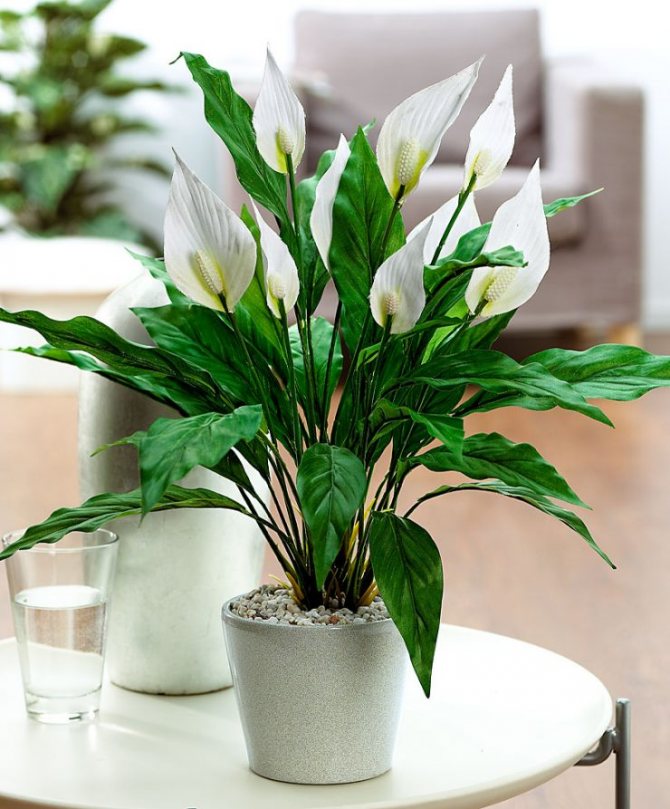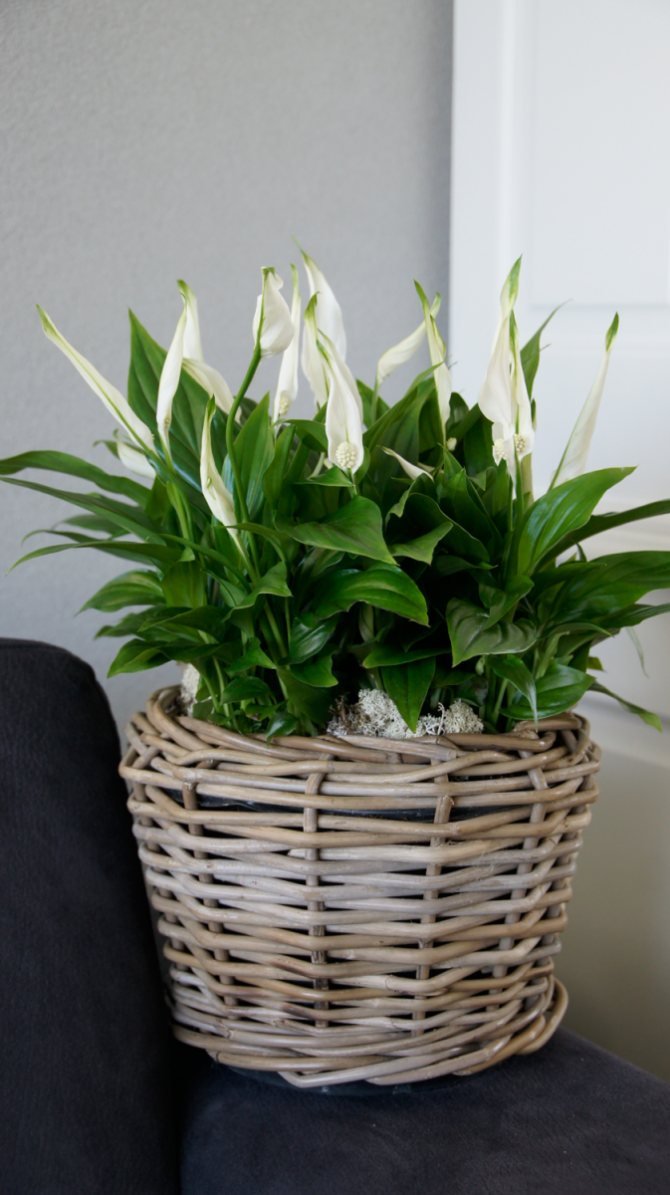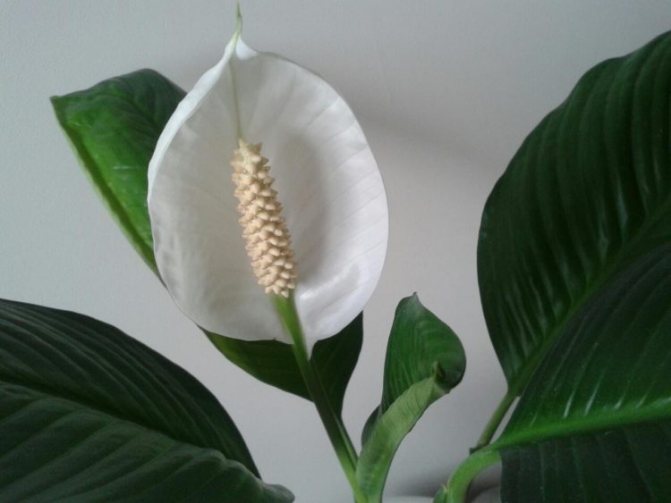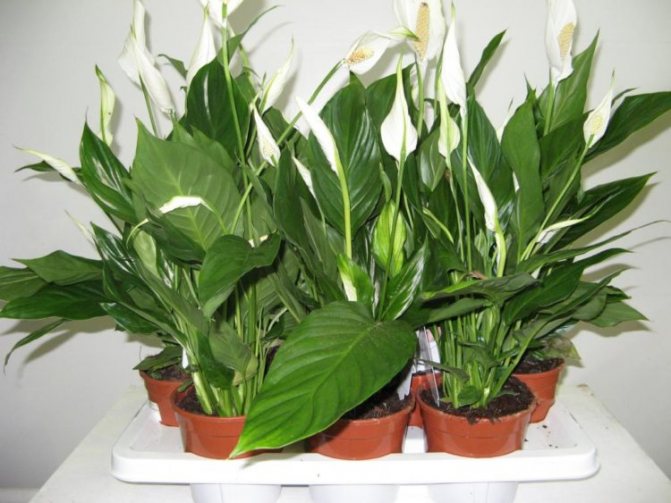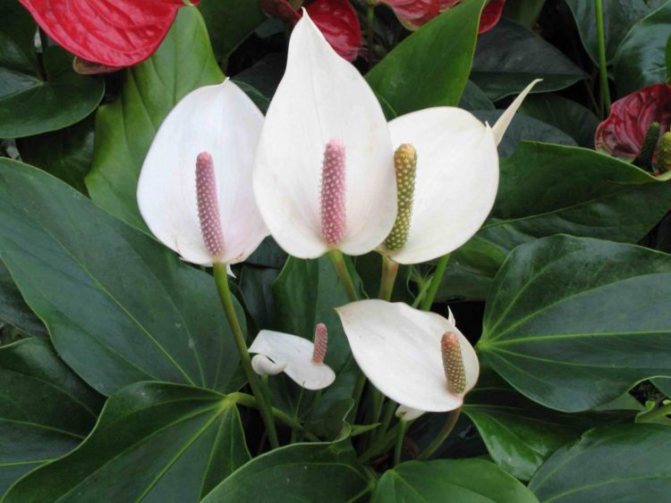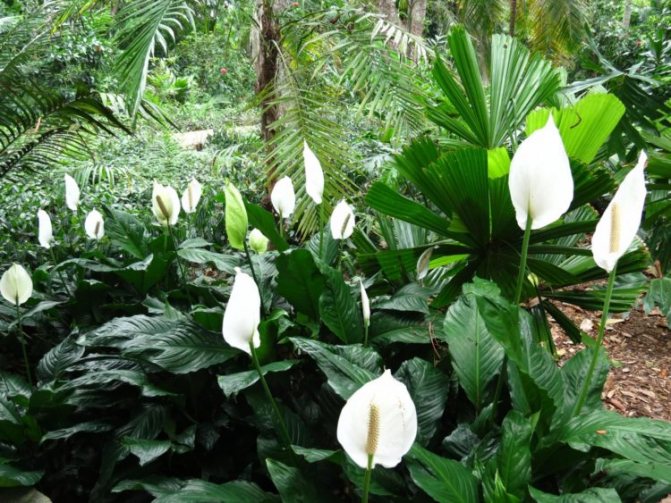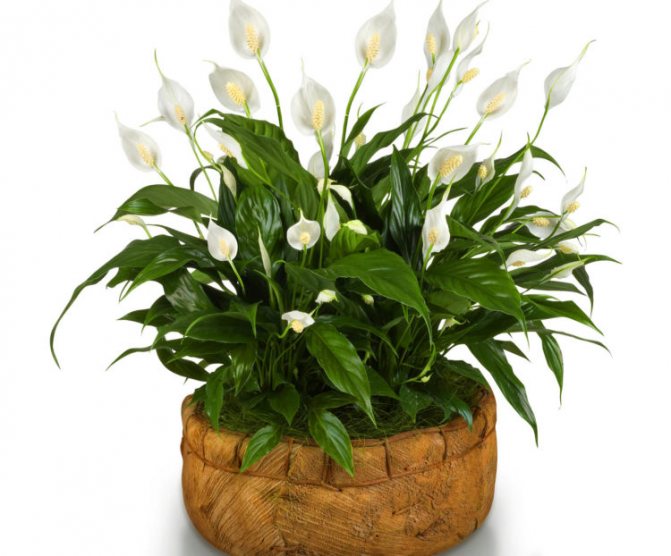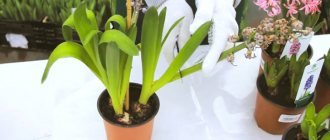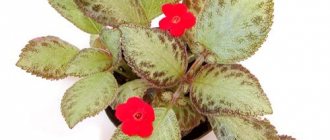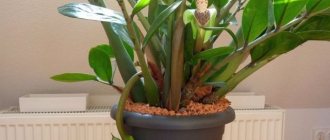Spathiphyllum is a very beautiful flowering plant that quickly gained popularity among amateur flower growers. It is called "White Sail", "Women's Happiness" and many legends and beliefs are associated with it. Spathiphyllum not only looks luxurious, it is loved for its unpretentiousness. But, nevertheless, you need to know some rules for caring for him, and especially transplants.
- 2 Preparing the ground for "Women's Happiness"
- 3 Transplant - step by step instructions
3.1 Planting the dividers
What affects female happiness at home on flower transplantation?
Season
You can transplant "female happiness" at any time of the year, the main thing is that the air temperature in the room is above +20 degrees. However, the best period for transplanting spathiphyllum is considered to be the end of winter - the beginning of spring, when the exotic begins to awaken after a period of rest.
Sometimes an urgent need to renew the soil of a flower arises in winter, for example, in December, then the owner does not need to think about whether this can be done, but to make sure that during the procedure the roots of the exotic are not frozen and transplant. Before starting it, you should heat the air in the room to 20-22 degrees with heating devices and install a humidifier.
Plant age
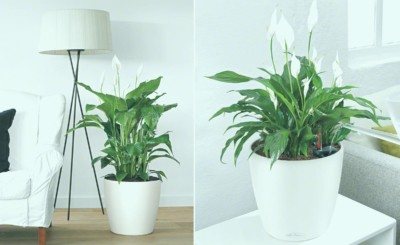
When choosing the optimal transplant schedule, it is recommended to pay attention to the age of the flower.
Spathiphyllum under 3 years old is considered young, as it is actively gaining growth. During this period, it is advisable to transplant it into a larger pot at least 1 time per year, so that the plant is not cramped. From 3 years or more, the flower is considered mature, and its growth slows down. Therefore, it is necessary to transplant it less often.
State of culture
The poor condition of the flower or the appearance of pests on it is a reason to transplant it as soon as possible. If you do not provide help to the plant in a timely manner, then it may soon wither away. Signs of a poor state of spathiphyllum:
- leaves become less elastic;
- the appearance of brown or yellow spots on the leaves;
- blackening of the corners of the leaves;
- the appearance of rotten areas on leaves and stems.
If at least one of the above signs is observed in spathiphyllum, then it is necessary to carefully remove it from the pot and check the condition of the roots. The presence of rotten and damaged areas on the roots suggests that the flower needs to be transplanted as soon as possible.
In this case, before transplanting, it will be necessary to put the plant in order by cutting off the affected leaves, stems and roots with a sterile knife.
But sometimes after transplanting, similar problems arise with the plant. Read about why the spathiphyllum dropped its leaves after transplanting, turned black or yellowed, wilted, read here.
Will the planter work?
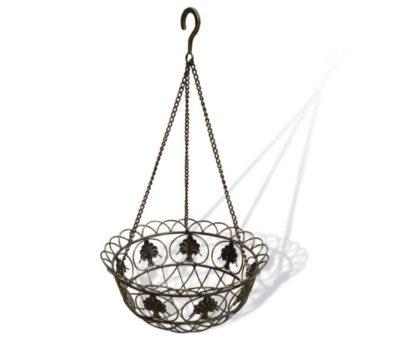

A cache-pot is a decorative container in which an ordinary container with a plant is placed. Unlike a flowerpot, the planter has a waterproof bottom with no drainage holes. This container is responsible for the aesthetic appearance, makes it possible to hide an unsightly flowerpot. If you look closer, the pots have a number of positive qualities:
- Ceramic flowerpots can build up white bloom on the outside, which is best hidden by a bright planter.
- The water trays on which the pot is placed can be turned over at any time, soiling expensive furniture or interior items. They also lose their neat look from old age, and it is the pots that will be appropriate in this situation. It will act as a reservoir for draining unnecessary fluid.
- Planters are often used to balance volatile colors.
- A decorative container is used to humidify the room. Expanded clay is poured into the air space between the planter and the pot, and water is poured. Evaporating, the water moisturizes the space near the plant.
- Replacing pots is much easier than replanting a plant, with a loss of attractive qualities.
When is a transplant needed urgently?
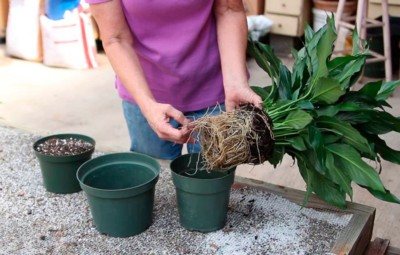

There are a number of cases when an urgent transplant is the only way to save the plant. Such cases include:
- Roots sticking out strongly from the soil and drainage holes, which indicate that the plant has catastrophically little space in the previous pot.
- Soil infested with various parasites.
- Infection of a plant with a fungus.
- Excess minerals in the soil.
- The flower has been flooded, causing the roots to rot.
- Withering of a recently purchased plant.
How to determine if spathiphyllum needs a transplant
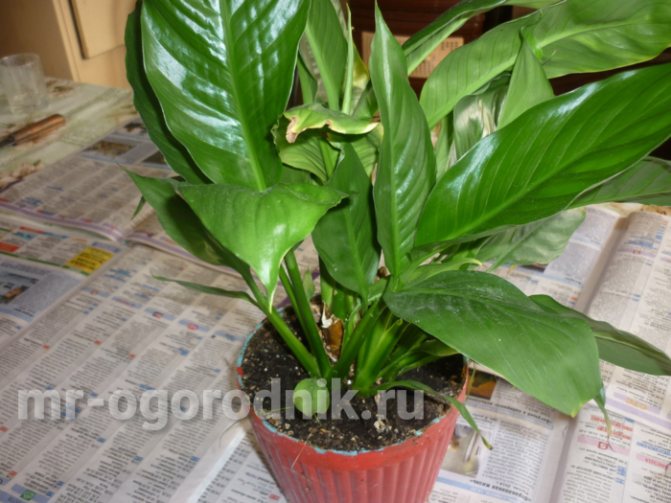

It is undesirable to transplant during flowering. If the plant is clearly cramped in the pot, and it literally bulges out of it, or the soil is depleted and looks like dust, then it's time to replant. If you have purchased a blooming spathiphyllum, and it is also clearly cramped in the pot, then you can transplant it using the transshipment method without disturbing the root system.
Important! Long stay in a tight container slows down the growth of rhizomes, and this is bad for flowering.
But this should not be done right away, but wait 1-2 weeks for the flower to get used to the new home and not get double stress. Also, if there is this handsome man in the house, but he does not bloom for a long time, then the transplant will help stimulate flowering.
How often is it best to do this?
During the period of active growth, it is recommended to transplant a young flower once a year or as it grows, when the plant becomes cramped in the pot.
In mature spathiphyllum, the soil is usually renewed less often, every 3-4 years or in emergency cases.
It is imperative to renew the soil, since over time it depletesand the roots will lack nutrients. And the structure of the soil itself becomes harder, which is why natural processes are disrupted: water is retained in the pot and oxygen is poorly supplied to the roots.
Consequences of a wrong purchase
Really, an improperly selected pot can cause a loss of plant turgor, yellowing and drying of foliage, lack of flowering. In one case, the pot is too cramped. An indoor flower grows quickly if the root system is placed on the surface - this is a sure sign that the size of the flowerpot is not suitable. As a result, there is a lack of moisture, minerals, and lack of space for further growth.
However, a pot that is too large and wide will also have a similar effect. In spathiphyllum, at first, the root system grows, which fills the entire space, and then shoots appear. And this is the reason that the exotic does not bloom and drops its leaves. When transplanting, the roots must completely fit into the new flowerpot. It is better to purchase a container 3-4 cm larger than the previous one.
It is recommended to choose a maximum size of 20 cm in diameter, otherwise you will not wait for flowering.
When is the procedure prohibited?
- It is not recommended to transplant spathiphyllum during flowering, as it is especially vulnerable during this period. If you disturb it with a transplant during flowering, then with a high probability the plant will begin to wither. And any damage to the roots can lead to the death of the flower.
- After buying a spathiphyllum in a store, it is not recommended to immediately start updating the soil (is it important to immediately transplant the purchased spathiphyllum, and how to do it correctly, read here). A change of scenery thus becomes stressful for the flower, and a transplant can only aggravate the situation. It will be optimal to wait 2-3 weeks, when the spathiphyllum gets used to the new lighting regime and the air temperature in the room, and transplant.
- You cannot transplant an exotic flower if the room temperature is low (below 15 degrees), as there is a risk of freezing the roots.
Thus, the ideal time for a spathiphyllum transplant is the beginning of its awakening after a period of rest, March and April. If you transplant it in time, then the plant will delight its owner with a long and abundant flowering.
If you find an error, please select a piece of text and press Ctrl + Enter.
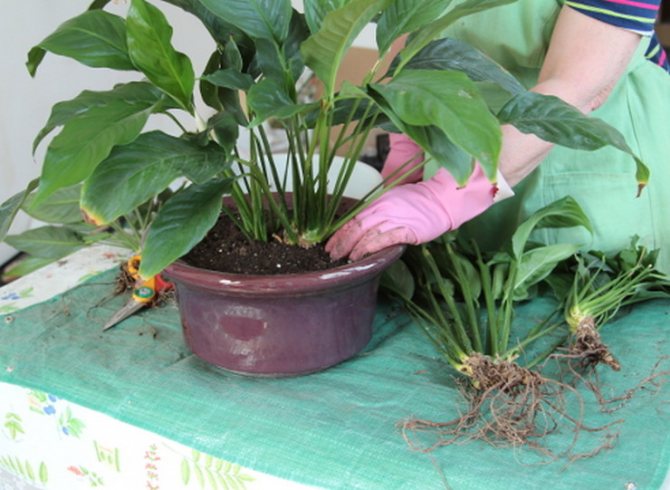

Spathiphyllum or "Women's Happiness" has long been popular among flower growers and common among numerous indoor flowers. A perennial evergreen plant is considered not capricious and not difficult to care for. With minimal effort, the flower will fully develop and often delight with its gorgeous flowering. When leaving, you just need to take into account the individual characteristics of a houseplant, as well as know the basic rules for watering, location, temperature, lighting and transplant time.
Spathiphyllum is a houseplant ideal for medium-light environments. The flower can create a cozy atmosphere in the apartment and a strict working atmosphere in the office, it can fit into any interior, thanks to its decorative qualities. With proper maintenance and care, the plant blooms twice a year.
Spathiphyllum is native to New Guinea and the rainforests of the United States of America. When kept in room conditions, it is necessary to take this circumstance into account and create a familiar level of humidity for the plant. Moisture plays an important role in the development and growth of spathiphyllum. It is very important to properly organize the care so that the flower receives a sufficient amount of water, light, heat and nutrition. Equally important is the location of the indoor plant in the room.
How to choose?
On the modern market, they offer a huge variety of flower pots. And this variety is sometimes confusing, it is quite difficult to choose a suitable container. Before going to the store, you should clearly define the main criteria for the product.
The size
The dimensions of the flowerpot for planting spathiphyllum directly depends on the size of the plant itself.
For seedlings 5-10 cm, a container is needed that does not exceed 9-10 cm in diameter. It is believed that these are suitable dimensions for the further development of the plant's root system. The older the exotic becomes, the more a planting capacity will be needed for it. For adults, a flowerpot with a diameter of 18-20 cm is suitable. The peculiarity of the roots is that they grow on the sides, and not down. Hence, it is better to choose a wide, but not deep flowerpot.
Material
The most common materials for flowerpots are plastic, ceramics, wood, and sometimes glass. There are two types of ceramics - porous and glazed. Due to the porosity of the material, excess moisture is removed through the walls, and the root system is saturated with oxygen. Ceramic flowerpots in the interior look rich and solid.


Also, ceramics is a natural material, environmentally friendly. On the other hand, glazed ceramics do not breathe. The material is quite fragile, and over time, salt deposits form, which are difficult to remove.
Plastic - lightweight, strong, durable material... The cheapness of this product often wins over flower growers. However, there are also downsides. Plastic pots do not breathe, and root rot may occur when overflowing. For tall plants - not a suitable option, they often lose their resistance.Wood, glass, metal are rarely used, they have more disadvantages than advantages in use.
Difference between current and previous capacity
Of course, with the growth of spathiphyllum, the volume of the new one should be slightly larger than the old one.
- When transplanting a flower with a division of rhizomes, 2-3 containers with a diameter smaller than the previous one will be required.
- When replacing the soil in an adult exotic, which is no longer actively growing, it will be enough to increase the size of the container by 1.5-2 cm.In this case, it is possible to transship a flower with a partial addition of a soil mixture (with recommendations on the selection and self-preparation of soil for spathiphyllum, you can read here)
- And provided that the spathiphyllum continues to grow, it is better to choose the current pot 3 cm larger than the previous one.
Can I plant in a transparent flowerpot?
Transparent planting containers are purchased mainly for growing indoor orchids, seedlings, when it is important to monitor the state of the root system. If you put a transparent pot on a windowsill with earth, then over time traces of algae will appear on it, which will spoil the overall appearance. You can place a transparent plastic flowerpot in a beautiful flowerpot that will be in harmony with the interior of the room.
Basic rules for caring for spathiphyllum
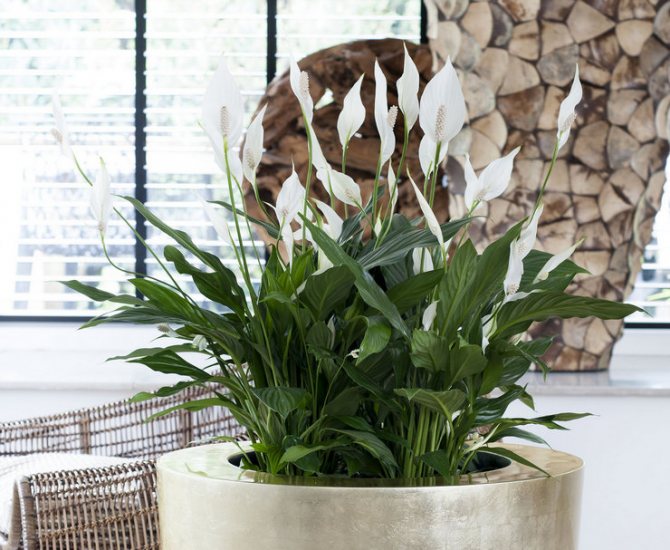

Location and lighting
A tropical flower has a negative attitude towards direct sunlight, so you should not put a container with splatiphyllum on the windowsill on the south side of the house. On the east, west and north windows, the plant will be more favorable. If there is no room on the windowsills, then it is possible to grow a houseplant in the back of the room. True, with such a location, additional lighting will have to be used, especially in the autumn-winter period.
Temperature
The indoor temperature for plants usually needs to change with the seasons (summer and winter), but for this flower it stays almost the same throughout the year. In warm months it is from 20 to 22 degrees, and in cold months - from 16 to 20. The main thing is that in winter the thermometer in the room with the plant does not fall below 16 degrees Celsius.
Watering and humidity
Tropical spathiphyllum requires abundant but infrequent watering from early spring to late October. All excess volume of irrigation water that will end up in the flower tray must be drained about 30-40 minutes after watering. Excess moisture in the soil should not be allowed, since the root part easily decays at a high level of moisture in the soil for a long time. If the earthen lump is constantly waterlogged, then the plant may gradually die.
Since moisture for spathiphyllum is very important for full development, it is worth spraying plants every day in the morning and in the evening from a spray bottle with a fine mesh. Another way to moisturize is additional vessels with water, which will stand in the immediate vicinity of the flower. There can be several such containers, one near each plant.
During the dormant period of the plant (in winter), the frequency of watering is much reduced, and the number of sprays is halved.
The optimum indoor humidity level for tropical spathiphyllum is about 70%.
Fertilization
In the period from March to October, and especially during active development and flowering, it is recommended to make fertilizing for flowering indoor plants. Complex fertilizers with all the necessary nutrients should be applied only to moist soil, preferably immediately after watering. During the dormant period, the plant needs less nutrients, therefore, fertilizing is applied only once a month. In all other months, fertilization is carried out 3-4 times a month at regular intervals.
The plant withers, the leaves turn yellow - what can be done?
Many growers complain that after transplanting their tropical pet begins to wither, drop leaves, and turn yellow. This is most often due to a lack of moisture. Spray the plant often (up to several times a day).
You need to water the flower carefully: an excessive amount of moisture in the soil can harm the root system, which will again lead to wilting of the leaves. Water spathiphyllum liberally, but only as the soil surface dries up.
Excessive sunlight can cause wilting. Spathiphyllum loves diffused light, and even more - shade. If you decide to keep the plant on a windowsill, give preference to windows facing north, west and east.
When and how to properly transplant spathiphyllum
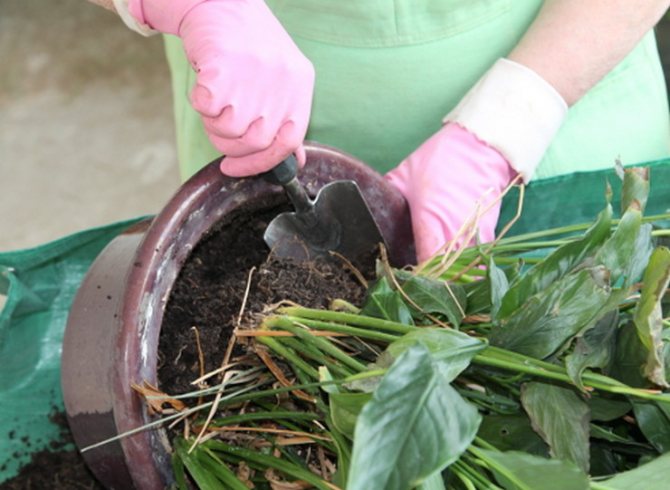

Transplant timing
Usually, the time of the onset of transplantation can be determined by the appearance and volume of the flower. At this point, it takes up most of the flower capacity. A transplant is necessary even when the plant continues to grow and bloom, because the overgrown root part continues to give its last strength to the flower. But it is still most favorable to transplant plants in early spring and always during the break between flowering periods. It is not recommended to disturb the flowering plant, as all the beauty will quickly fade.
It is recommended to transplant the flower for the first time about 15-20 days after purchase. Spathiphyllum needs a spacious container. After each transplant, the size of the flower container should be selected one larger than the previous one.
Selection of soil mixture
Potting soil can be prepared at home. For cooking, you will need: coarse sand, leafy earth and peat - one part at a time, sod land - two parts, small chips of broken brick and wood ash - half a part.
Among the wide variety of commercial mixtures, it is better to opt for a soil mixture for plants of the Aroid family. These plants include spathiphyllum and light loose soil is ideal for it. It is worth paying attention to the level of acidity of the substrate, it should be slightly acidic. This soil mixture will make the living of tropical spathiphyllum at home comfortable and supportive.
Transplant rules
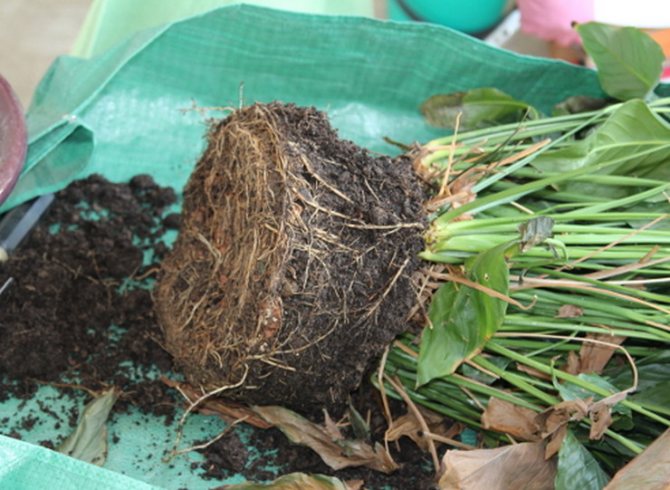

It is very important not to damage the root part of the plant during transplantation, since it is very fragile and vulnerable in spathiphyllum. That is why it is best to use the method of transshipment of the earthy coma along with the plant. Before the procedure, the flower must be watered abundantly so that the moist soil, along with the plant, can easily separate from the flower pot. If the overgrown root system has wrapped around the drainage, it must be removed from the plant. It is also necessary to carefully examine the condition of the root part and, if there are damaged and diseased parts, it is advisable to remove them. It is recommended for such plants to treat the root system with special preparations for prevention and full further development.
Before planting a plant in a new container, you need to free it from dried old leaves and cut off the children. Young shoots of a flower (babies) are an ideal planting material and an excellent way to propagate it. A mature plant will only benefit from such removal.
The container after transplantation should be one size larger, its bottom should be filled with a small layer of drainage. You can use for this large river or sea pebbles, broken brick or expanded clay. After the drainage layer, it is necessary to pour the substrate up to half the pot, put the plant, straighten all the roots and add soil to the top. The soil must be compacted a little and watered abundantly. If necessary, the soil can be filled up after settling so that the flower sits tightly in it.
Spathiphyllum care immediately after transplant
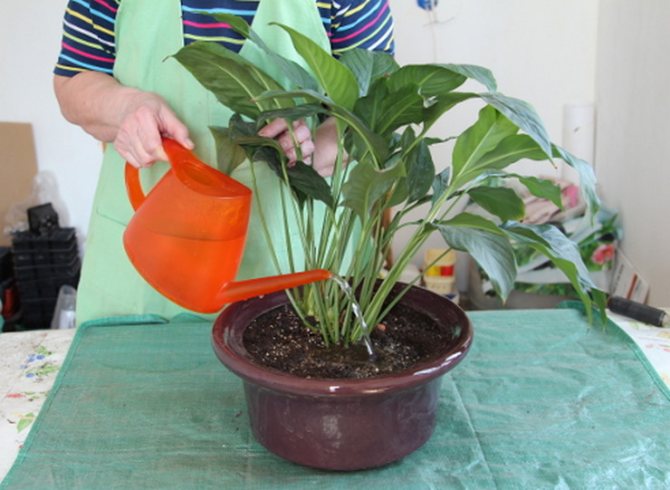

After transplanting, you must immediately go to "water procedures" - this is watering and spraying.After abundant watering, you will have to drain the water from the pan after a while. Spraying is carried out using a spray bottle or other spray. The moisture will ease the stressful transplant procedure for the houseplant and help it settle down in its new location.
Secrets of proper care in the first month after transplant
To shorten the process of acclimatization of spathiphyllum after transplantation, you will need a mini-greenhouse. It will provide the plant with the right amount of moisture in the first few weeks, which will significantly bring the onset of flowering. The entire aerial part of the indoor flower must be placed in an ordinary plastic bag, putting it on top of the spathiphyllum. Such a cover will only need to be removed for airing and watering and spraying. It is recommended to maintain such care for at least the first two weeks.
Lack of moisture can lead to yellowing and wilting of the leafy part. If negative signs appear, it is worth increasing the number of sprays up to 2-3 times a day, and watering should be carried out only after the top layer of the soil has dried by about 5-10 millimeters.
The decorative qualities and the unique flowering of spathiphyllum will be at the highest level only if all recommendations for the care and maintenance of the plant are followed, as well as if the timing and methods of transplantation are observed.
Preparing the ground for "Women's Happiness"
This plant thrives on loose soils with a slightly acidic reaction. In specialized stores, you can buy a universal soil mixture for aroid plants (which includes spathiphyllum) or for flowering tropical plants. It needs to be mixed with a little sand.
You can prepare the soil yourself at home, if possible. So, what material and in what proportions you need to mix:
- 1 piece of leafy land;
- 2 parts of sod land;
- 1 part peat;
- 0.5 parts of charcoal;
- 0.5 parts of brick chips;
- 1 part coarse sand.
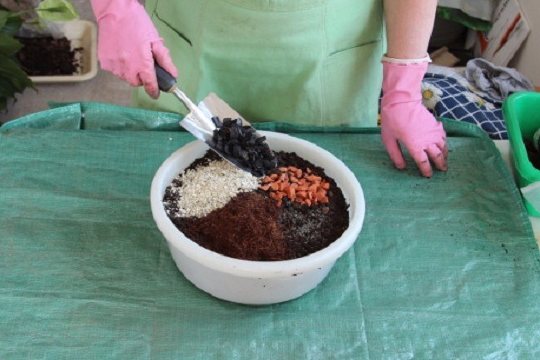

You can independently prepare the soil for transplanting a flower
Charcoal can be replaced with pulverized tree bark or coconut fiber. Add some superphosphate to enrich the soil. It is important to note that the amount of additives was no more than 10% of the total mass of the substrate. This way you will achieve good aeration (air ventilation) and moisture holding capacity of the soil.
What you need to know before transplanting
The comfortable temperature, in principle, does not fluctuate too much. So average and ideal is about 20 degrees, give or take two.
- From early spring to mid-late autumn, it is rarely required, but at the same time, it is necessary to water abundantly.
- Some time after watering, you need to wait about half an hour, plus or minus 10 minutes.
- In the event that water remains on the surface, then it is required to drain it.
- The abundance of moisture is unacceptable - the roots begin to rot, but even without water, "happiness" will not live long.
- The water must definitely settle or be soft.
Tools for the job
You will need a minimum of tools:
- garden shovel or scoop;
- sharp knife or scissors;
- spray.
Did you know? The first flower clock was planted nearly 300 years ago (in 1720). Swiss gardeners have become pioneers in this direction.
You will have to work with gloves (preferably rubber - wearing cotton, you can miscalculate with effort and damage the rhizome).
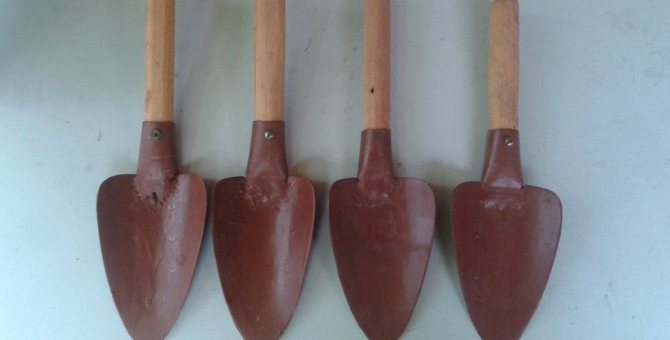

Flower transplant
Things that will be needed in the future:
Plant preparation
It is necessary to clean out the roots, remove the old soil. If you are afraid of damage, then in the process you can use a wand. In the event that the bush is thick and heavily overgrown, then it is advisable to divide it. This will give them new space to grow. But look carefully, each outlet should have a good length of rhizome. That is, strong, healthy and without damage.
For transplanting, take a pot that will be slightly larger than the previous one, all because the flower will bloom only when the roots completely occupy all the space provided for them. It is advisable to use not tall vases, with a diameter of 15 to 20 cm.
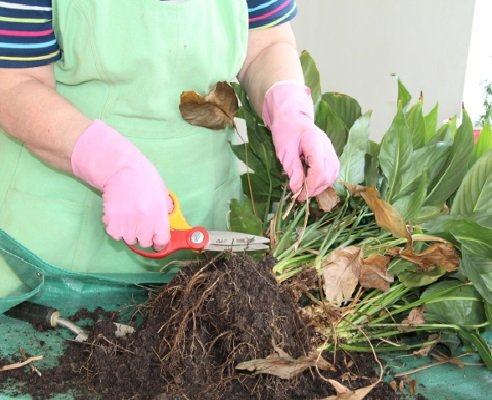

Also, it is necessary to prepare the plant itself for transplantation. As a rule, the roots of "Women's Happiness" are very tender and it is not advisable to touch them, but only for a full-fledged transplant, you will have to:
- get rid of dry tips on the leaves;
- get rid of wilted or too young flower shoots;
- trim the roots so that they are all on the same level;
- cut the stalks - it is advisable to use pruning shears or scissors for this.
- if you find decay, then you should immediately get rid of it - you can soak them in Previkur's solution;
- if there is damage, then they should be cut off and sprinkled with activated carbon.
Tear off the base of old leaves, but proceed with caution.
Continue peeling off layers until they give in easily, otherwise don't touch - just harm the flower.
After inspection, it is necessary to rinse the spathiphyllum under warm water to remove the remaining dry scales.
Priming
The soil mixture itself should be prepared. You can buy it ready-made in the store or mix it yourself. If you chose the second option, then in this case you will need:
- one share: larger sand, leafy soil, peat;
- two shares: sod land;
- one and a half shares: charcoal, brick chips.
Expanded clay or river pebbles can also become a drainage material. It is recommended to add perlite or vermiculite to preserve soil moisture.
Important! Tropical spathiphyllum adores slightly acidic and soft earth, therefore, if you still go to buy, then the best option for you will be a soil composition for plants of the Aroid order, which, by the way, includes spathiphyllum.
By choosing it for your plant, you will provide complete comfort and a favorable environment for your tropical "Women's Happiness".
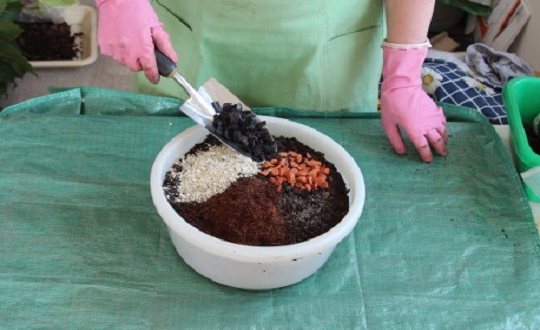

- During the transplant itself, at the very final stage, it is necessary to slightly deepen the leg, and crush the ground around it. The outlet should be standing, not tilting or, moreover, wobbling.
- Do not deepen aerial roots.
- Be sure to water the "Women's Happiness" after the transplant.
- Spray the leaves with a spray bottle.
Is pine bark needed for soil
It is advisable to add a few small pieces of pine bark to the prepared substrate. You can use dried bark from trees for this or buy it. It is an additional drainage of the soil and helps to maintain the desired moisture.
The most important quality of the bark is its fungicidal effect, which has a detrimental effect on all kinds of parasites. Pine bark has the ability to keep the soil warm in cold weather, and in hot weather it serves as a source of coolness. After the soil has been prepared, it is important to choose the right pot.
When is it better to replant: in autumn or spring
The best time to transplant is spring. Before awakening, but before flowering, it can be carried out in the fall. However, there are cases when it is possible to carry out unscheduled transplants, namely:
- in case of damage;
- noticeable disease;
- when buying in a store;
- insects started up.
For example, if it withers, dries up, or yellowing of the lower leaves is noticeable. It is necessary to make a sanitary transplant. Such an unscheduled event will not harm the pet.
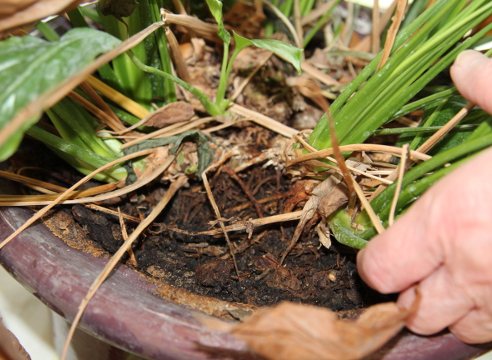

How to propagate spathiphyllum
Spathiphyllum is easy enough to grow at home, it is not whimsical to care for and has a unique ability to easily reproduce. There are several ways to propagate a flower: by seeds, cuttings and dividing a bush. Let's dwell on them in more detail.
Seed propagation is the most time consuming method of propagation. It will take a lot of time and effort.I note that it is almost impossible to independently obtain viable seeds from the mother plant at home.
The main problem is artificial pollination of spathiphyllum and the rapid loss of germination in seeds. It is much easier to purchase seeds from specialized stores. But even in this case, the percentage of germination of even the freshest seeds is about 50%.
There is another problem with the seed planting method - this method does not imply the transfer of signs of the mother bush. Spathiphyllum bloom with this method of planting occurs in 3-4 years. At the same time, there is a high probability of getting a completely new variety.
An easier way to propagate spathiphyllum is by cuttings. You can propagate in this way at any time of the year, but spring is considered the best time, when the plant is preparing for growth after winter, but it is also possible in summer.
You will need a sharp knife to get the cuttings. Dip it into the ground between the mother bush and the outgoing cuttings to a depth of about 2 cm, there is a connecting root that runs from the adult bush to the baby, and cut it. When cutting, a characteristic crunch occurs. Then remove the cutting from the soil.
If there are small root shoots on the handle, then it can be immediately planted in the ground. If not, then the cutting is placed in a glass of water until the roots appear. It is advisable to close the glass with the handle with a bag, but every day it is necessary to ventilate.
When cuttings are rooted in water, water blooms often occur, and bacteria proliferate rapidly, causing rotting and an unpleasant odor. Add a few tablets of activated angle, it will keep the water fresh, odorless.
After the growth of the root system, the cuttings are planted in the ground for permanent residence. The soil is chosen the same as for transplanting adult plants. The flowerpot should be small.
There is another method of flower reproduction - division. This method is used when a complete transplant or transfer of a plant is carried out. In this case, it is very convenient to divide the rhizome, since the flower is completely removed from the pot in which it grows.
When dividing a bush, you do not need to increase the pot, since after dividing the root mass will decrease. The division process is as follows:
- Water the plant ahead of time, this will make it easier to remove from the pot.
- Remove the root ball and prune the roots if necessary if they have grown into the drainage holes.
- Gently remove all soil from the roots. If clumps come across, spray with water and soften. Be sure to cut off damaged and rotten roots.
- Then, using a sharp knife or pruning shears, cut the root system so that each division has a rosette of leaves with a growing point and its own root system. Sprinkle all sections with charcoal or pre-crushed activated charcoal purchased from a pharmacy.
- Put the divided rhizome on paper or a towel to dry and heal the wounds that appeared when cutting. At this time, you can prepare flower pots for subsequent planting of divisions in them.
- Be sure to put a drainage layer in the pots and a little earth on top, crush it. Place the roots of the delenoks, gently cover them with earth and crush them with your hands. The root collar should be on the surface. Be sure to water the flowers and spray the leaves with a spray bottle.
Transplant instructions step by step
- Before transplanting, you need to ensure that the flower is watered along the edge of the pot. When the water is absorbed, very carefully pull the plant out, being careful not to damage the roots.
- Check roots for integrity. Cut out damaged and rotten elements with scissors. Be sure to sprinkle with activated charcoal and dry.
- Transfer to a prepared pot (with drainage and soil), while setting in the center. Add soil to the missing places. Drizzle with water.
- Add soil when settling after absorbing water. Spray the leaves with water. For this, home sprayers are used. It is better to add a drop of any growth stimulant to the water. This will help relieve stress on the plant.
- Check for stability so that it does not fall over.
Transfer or transfer, the right choice
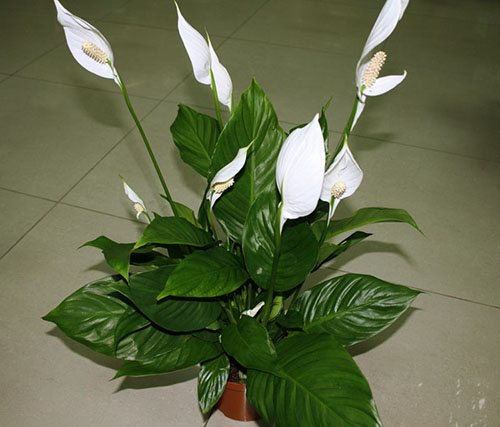

We know that transshipment is a method of changing a container without disturbing a clod of earth connected by roots. In this case, the plant is abundantly moistened, but not so much that the earth turns into mud. It is enough for it to slip out of the cramped pot easily like clockwork without damaging the roots.
At the bottom of the new container, a drainage layer of 2 cm, 2 cm of soil and an undamaged lump of earth with roots is placed on top, having previously selected pebbles and expanded clay from the lower beard. On the sides, soil is poured for spathiphyllum, it is slightly compacted, slightly watered.
When wet, the earth will settle, it must be added to the neck. Shake the pot a little, make sure that the plant does not fall over, stands in the center. For several days, the new plant should be sprayed over the leaves, but not watered.
If you really need it, then you can also handle a flowering plant, but a spacious pot will create conditions for the termination of flowering.
If the plant is newly acquired, then is it necessary and how to transplant spathiphyllum after purchase? Yes, you do, but only after preliminary quarantine for 2 weeks. The soil on which the plants for sale are grown contains a lot of peat and is filled with nutrients only for the first time.
Just as during transshipment, a layer of drainage and earth is prepared, roots are placed on it and carefully sprinkled with soil for spathiphyllum, with gentle shaking to compact. The sprinkled roots are moistened, the soil tightly fits the roots, the earth is again poured up to the neck.
But such a transplant of spathiphyllum requires careful observation for 2 weeks and frequent spraying of the leaves. A sealed hood over the plant will keep moisture and promote rapid establishment.
In order to plant spathiphyllum thickets, you will need to completely immerse the plant in a container with water and let the earth turn into mobile mud. After that, extract the plant, and, spreading out on a horizontal plane, select young plants, cut the rhizomes of the old so that together with the root there are up to 5 leaves.
Plants that have a root system can be planted directly into containers. If there are no roots on the layers, they must be germinated in a glass of water. Transplanting spathiphyllum during reproduction is no different from how to transplant spathiphyllum after purchase.
In all cases of transplanting and transferring, the plants are not watered until new leaves begin to appear. This means that the plant is rooted, and moisture will not harm it, and rot will not appear.
Post-transplant care
At first, or rather about two to three weeks, spathiphyllum is in dire need of high humidity. For those who do not want to wait long for the plant to bloom again or bother with special care, then here's a piece of advice: move the pot with "Women's Happiness" to a greenhouse or something similar. Similarity means, for example, a plastic bag. Under the so-called "hood" a greenhouse effect is formed and the plant feels very good.
The only thing you will need in the future is to take out the spathiphyllum for airing. If you go a long way and do not use a mini-greenhouse, then keep an eye on the humidity level. If it is in short supply, the flower will begin to turn yellow and wither. Then it is required to spray up to three times a day, watering only when the soil dries up (about 5-10 mm).
There are some simple steps to follow to speed up survival and prevent disease.
Air humidity
The plant needs to provide sufficient air importance. Observing this condition, you can achieve the appearance of beautiful leaves without spots. It is important to spray spathiphyllum daily with water from a sprayer. In the summer, the number of spraying is increased. You can increase the humidity by placing a jar filled with water next to the plant.
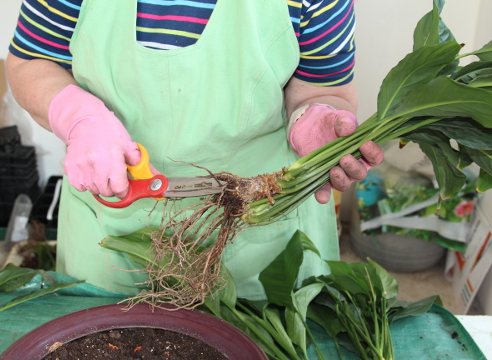

Watering a flower
Balanced watering is required. With insufficient moisture, the leaves turn yellow. If the leaves have dropped down, they look lethargic and lifeless, then this is also a signal of a lack of water. Moisture must be present in the roots of the flower. Watering must be carried out when the top layer of the earth in the pot dries out.
For irrigation, it is advisable to use filtered water at room temperature. It is recommended to add 5 drops of vinegar 9% to 1 liter of water, the flower loves acidified water.
Attention! With excessive watering, flowering will not come!
If the plant has dropped its leaves, this indicates an excess of moisture. In winter, watering spathiphyllum is reduced, removed away from heating appliances. It should be remembered that you cannot overmoisten the soil. The roots should not be in the water, this will lead to decay. After each watering, excess water is poured out of the pan.
Sun exposure
The sun's rays have a detrimental effect on spathiphyllum. In this case, spots with burns appear, then the leaves die off.
Important! When the first signs of sunburn appear, urgently move to another place. The plant may die in the sun. It will develop well in a small partial shade.
When to feed
The transplanted plant is fed with fertilizers starting from 5-6 weeks after transplanting. Fertilizers are applied during the growing season (spring and summer) once a week. The rest of the time, the flower is fed once a month. For top dressing, fertilizers containing nitrogen and a small amount of potassium are used. It is necessary to strictly follow the instructions for breeding the fertilizer, since an overdose can lead to undesirable consequences, then to death.
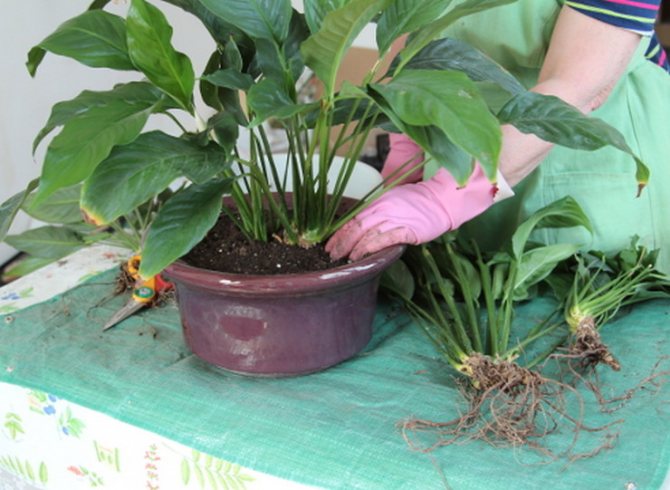

Preparing spathiphyllum for transplant
The initial stage of transplantation is the preparation of the flower itself. In the case of spathiphyllum, it is carried out according to the following algorithm:
- The soil in an old pot is moistened abundantly, after which it is carefully pry on with a garden spatula.
- The plant is removed along with the lump.
- Then the rhizome is carefully cleaned of old drainage and soil.
- Withered or too young leaves are cut off (at one time, do not torment the flower).
- Take a closer look at the old leaves, and especially at their bases - they are also removed (to prevent rotting). Usually they are cut off without much effort.
- It remains to cut out too long or rotten roots - and the spathiphyllum is ready to move to a new container.
The transfer of adult specimens is often combined with reproduction. To do this, the cleaned root ball is cut into several fragments, making sure that each section gets a healthy piece of rhizome.
Important! The cut points are sprinkled with charcoal in the form of a powder - it is a kind of antiseptic.
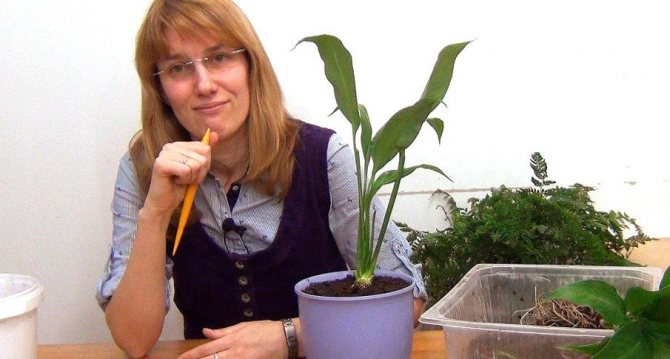

Keep in mind that if the transplant has not been carried out for 2-3 years, then there will be many such outlets, therefore, if there is no space for new pots, it is better to refuse dividing.
Questions and Answers
A few very popular questions:
What problems can you face after transplant
Some time after transplanting, the tips of the leaves may dry out on the plant, yellow spots may form. The formation of yellow-brown spots indicates overflow. In case of an overdose of fertilizers, blackening of the flowers may be observed. If blackening is found, the soil should be treated with a foundation solution. Dissolve 2 grams of the drug in 1 liter of water. Yellowing occurs due to improper watering or when kept in a too sunny place.
Important! Feature - after flowering, yellowing of the leaves is considered a normal process and does not require intervention.
With a lack of light, narrow long leaves grow in spathiphyllum, it is required to change the place.
Why isn't it blooming?
There are many reasons:
- lack of minerals;
- old age;
- lack of moisture;
- low temperature.
Why did the leaves turn black?
There are, again, several reasons:
What to do in this case? Take the plant out of the pot, cut off new roots and move it into a new, pre-treated pot with new soil.
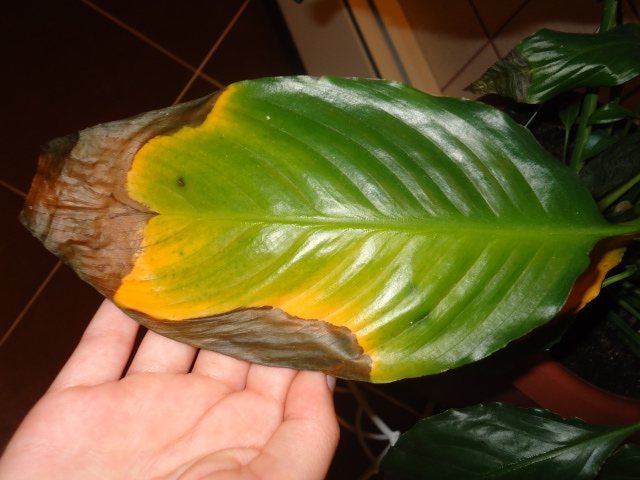

How to get rid of parasites?
Our main enemies were aphids and spider mites. In order to get rid of unwanted neighbors, you should cover the ground around the plant with a film and do not allow the soap and nicotine sulfate solution to be absorbed while you wash the leaves. The procedure needs to be carried out several times, but the parasites are gone.
Other pests can also cause poor growth and development:
- A sooty mushroom. The blackening of the leaves indicates the appearance of the fungus. It is localized on the upper plate of the leaf, disrupting the respiration of the flower. The measure of influence is to carry out soap spraying.
- Mealy worm. Detected in high humidity. Hiding among the leaves. Inspect periodically for pests. With a small number of copies, it can be removed with a cotton pad dipped in an alcohol solution. An infusion of citrus peels is considered effective; it is used to treat mealy worms. Take 100 grams of crusts, place in 1 liter of water, keep in a dark place for 2 days. Wipe the leaves with the resulting solution.
- Shield. Juveniles are barely visible. The appearance of dark spots on the stem and leaves indicates the presence of a scale insect. A good result is achieved by spraying a soap-tobacco solution with the addition of denatured alcohol or kerosene. To treat a plant from aphids and spider mites, you can use an infusion of onion husks. Heat 5 liters of water to 40 degrees, soak 100 grams of husk. Keep in a dark place for 2 days, then process the leaves.
Spathiphyllum is a very beautiful flower and, moreover, picky to care for. It can become an irreplaceable part of your decor - whether it is a simple apartment or even an office, it does not have the slightest importance, it looks harmonious anywhere. However, if you do not follow the rules of care, if you ignore his needs, then it is unlikely that "Women's Happiness" will be able to please you in the future with its delicate flowers.
Diseases and pests (table)
Spathiphyllum is an unpretentious plant and can delight with its flowering all year round. And it is very unpleasant to see that your pet is sick. As much as you want it, sooner or later you have to deal with it.
Diseases can arise from improper care or from insect pests. Sometimes the symptoms are very similar, which makes it difficult to determine the cause. Outwardly, you can find out whether your flower is sick or not, you can first of all by the leaves, they begin to blacken, turn yellow, wither and rot. Let's define the causes of diseases.
In spathiphyllum, leaves may turn black and dry. This manifests itself in different ways: the tips may dry out, a dark strip appears along the edge of the leaf, the leaves begin to turn black completely or in spots. How to act depending on the symptoms?
- If a small black edge appears on the sheet plate, the air in the room is too dry. Usually appears in winter, after turning on the central heating. Solution: increase air humidity by means of a humidifier, spraying. As a way out - place the flower pot on a pallet with wet expanded clay. Water evaporating from expanded clay will humidify the air surrounding the flower.
- Blackening of most of the leaf most likely indicates root disease, in most cases this is due to frequent overflow.Solution: stop watering, let the earth dry. If the spread of stains does not stop, you need to remove the plant from the pot, remove the rotten roots, rinse, sprinkle the cuts with crushed coal or ash. After drying, plant in a pot with a new earthen substrate.
- Black spots in the middle of the leaf - a possible fungal infection of the plant. Fungi cause root and leaf rot, resulting in dark spots. Solution: Immediately remove the affected parts of the foliage and spray the plant with a fungicide. It is also necessary to inspect the substrate: if it is too wet, the flower must be transplanted into a new soil, while inspecting the roots and removing the rotten and blackened ones.
- The tips of the leaves turn black - lack of moisture or plant flooding. Solution: if only the very tips of the leaves turn black, this is most likely due to low humidity. In this case, you need to raise it: place the flower pot on a pallet with wet expanded clay, spray it with a spray bottle. In the case of a bay, the tips dry a little differently - the blackening appears more extensively and affects part of the leaf. Often, in this case, there is still no root decay, just adjust the watering.
- Another reason for blackening is hidden in the increased dose of fertilization in the soil. The fact is that the roots simply cannot cope with so much nutrients and begin to rot. Literally overnight, after watering with excess fertilizer, extensive brown or black spots may appear on the leaves. The only solution to this problem is to transplant into a pot with fresh substrate. In this case, the roots of the spathiphyllum should be washed in clean water and transplanted into a new soil.
In addition to blackening, spathiphyllum leaves can turn yellow. The reasons are also varied, let's look at them and try to find solutions.
- The leaves lose their rich green color, become covered with dry brown spots, become very thin - possibly due to sunburn. Solution: it is necessary to remove the plant from direct sunlight, completely cut off damaged leaves, spray with Epin or Zircon at the rate of 2 drops per 250 ml of water.
- The leaves turn yellow, turn pale, become narrow - a lack of lighting is possible. Solution: move the spathiphyllum closer to the window, if this is not possible, use a phytolamp for additional lighting.
- Shoots and leaves become smaller, the peduncle is shortened, the veins of the leaf remain green - a lack of iron is possible. Solution: a folk remedy is to stick an iron carnation into an earthen substrate or to fertilize with complex fertilizers for flowering crops.
- Adult leaves turn yellow, and young leaves in the center of the bush remain green and bright - a lack of magnesium is possible. Solution: use complex fertilizers for flowering crops.
I have already indicated the main reasons why the tips of the leaves of spathiphyllum can dry. This is mainly due to the lack of humidity in the air and soil substrate. Sometimes, fearing to flood the flower with water, they begin to water it only when the earthen lump is completely dry.
Such extreme changes in humidity are also bad for the plant, and it begins to dry out and wilt. Do not forget that spathiphyllum comes from tropical countries, and moisture is vital for it.
To prevent pests and diseases from attacking your spathiphyllum, observe basic hygiene. Keep the foliage clean, be sure to keep new plants in quarantine, follow the rules of maintenance and care.
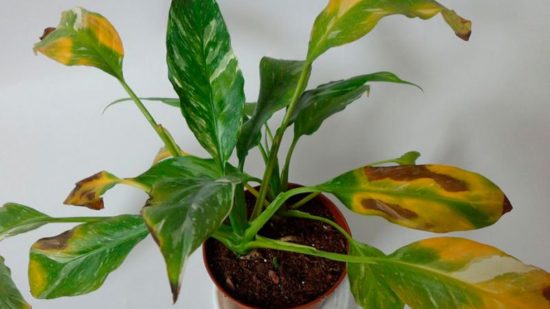

Such spots can be the result of a burn or pest attack.
What difficulties may arise during a transplant
After transplanting, the leaves of the plant may drop. This suggests that the watering was too abundant. It is recommended not to allow stagnation of water in the sump, and the earth should not look like a swamp outwardly.
Foliage yellowing and drying out may indicate that the air humidity is too low.Foliage can take on this shade due to sunburn, which forms when direct sunlight hits it.
What to do if the transplanted flower begins to wither
What if, after transplanting, the spathiphyllum has dropped its leaves? Watering less often. Carry out it no more than once every 2-3 days, avoiding excessive moisture of the substrate. When the leaves turn yellow, it is recommended either to regularly spray from a spray bottle, or to purchase an air humidifier that will not only create a cozy atmosphere in the room, help moisturize the foliage, but also have a beneficial effect on the health of the grower.


Fading spathiphyllum can be saved if the temperature in the room is normalized
What should be considered when choosing?
The variety presented to shoppers in stores is seriously confusing. therefore before buying a container for spathiphyllum, it is better to arm yourself with information, and only then go to the store.
The size
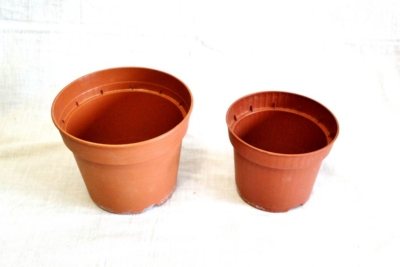

- A pot with a diameter of 9-10 cm is perfect for spathiphyllums 5-10 cm in height. This size will be ideal for the rapid development of the plant's root system.
- For flowers that are 2 - 3 years old, you can purchase a container with a diameter of 18 - 20 cm. The main thing to remember is that the rhizome of spathiphyllum grows to the sides, and not down, therefore the pot should be wide and shallow.
Material
For growing spathiphyllum, materials such as plastic, wood, in rare cases glass, ceramics are suitable, but flower growers prefer the latter, which is due to a number of advantages:
- Porous ceramic pots allow the plant to breathe and remove excess moisture from the substrate through the walls of the pot.
- This material is environmentally friendly, and therefore absolutely harmless to spathiphyllum and any other plants as well.
- Ceramics are perfect for all types of interiors, because they look expensive and solid.
The second most popular material is plastic. Its main plus is a very low price, but, unfortunately, this is where its advantages end. In such containers, plants will not be able to breathe, they also often rot.
Difference between old and new packaging
A new container for spathiphyllum should be slightly larger (in particular by 3 cm in diameter) than the previous one if it is planned to be transplanted (1 time in 1 to 2 years), but a new flowerpot may be required in other cases:
- When a plant is propagated by dividing the rhizome, a pot is needed, 2 - 3 times smaller than the capacity of a plant divided into parts.
- Spathiphyllum, which has ceased its active growth, can increase the size of the pot by about two cm every 2 to 3 years, and add a substrate if necessary.
Can a flower be planted in transparent containers?
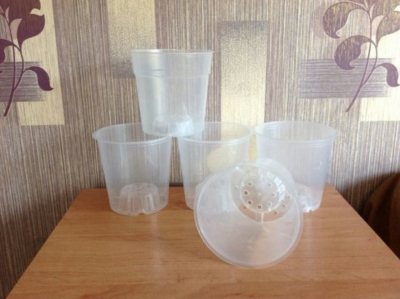

A transparent container for spathiphyllum can be made of glass or plastic. These materials are not suitable for this plant, but its transparency will help novice growers to avoid overflow of the substrate and thereby prevent root rot.
White bloom or traces of algae usually accumulate on the walls of the containers, which spoils the appearance of the plant, but this can be corrected by placing the pot in a planter.
Plant features
Before proceeding to consider the containers most suitable for this plant, you need to figure out how to grow it correctly. By itself, spathiphyllum differs in that it does not have stems, which is why the foliage grows directly from the roots. The whole leaves have a characteristic oval shape. They also have noticeable relief veins. From time to time, this plant produces inflorescences with rather long legs.
This plant during the flowering period is very similar to the snow-white calla with a characteristic yellowish branch in the core.
After some time, the flower takes on a greenish tint, and then dries up altogether.The flowering itself lasts up to about a month (maximum), as a rule, a couple of times a year. Many people choose spathiphyllum to decorate their homes, because this plant is unpretentious, does not require complex maintenance and amazes with its attractive appearance.
Many are interested in whether it is possible to grow spathiphyllum in the same pot with a plant such as anthurium. This is not worth doing, since the care of these plants varies. Spathiphyllum needs more moisture, and anthurium is more "to its liking" content in dry conditions.
Step-by-step instruction
Spathiphyllum is transplanted by the transshipment method.
Reference! Transshipment is a type of transplant that involves moving the plant into a larger container while preserving the earthen coma.
The procedure involves performing several consecutive actions or steps.
Step 1. The transplant of spathiphyllum begins with the preparation of the plant. For this:
- At least 30 minutes before the procedure, the flower is well watered. This will make it easier to remove the earthy clod from the container and avoid trauma to the roots.
- The roots are examined. All suspicious (rotten, deformed) areas are removed. Slices are sprinkled with crushed charcoal and dried a little.
- All old leaves are removed from the plant. This will make it easier for the flower to take root.
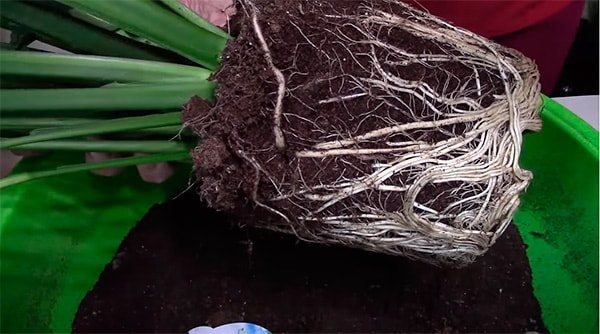

Step 2. Pot filling:
- Drainage is laid on the bottom of the new container in a small (2 cm) layer: small expanded clay, pebbles or brick chips.
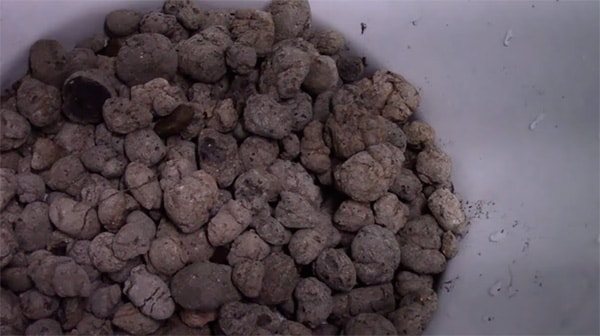

- On top of the drainage, no more than half the pot, soil is poured.
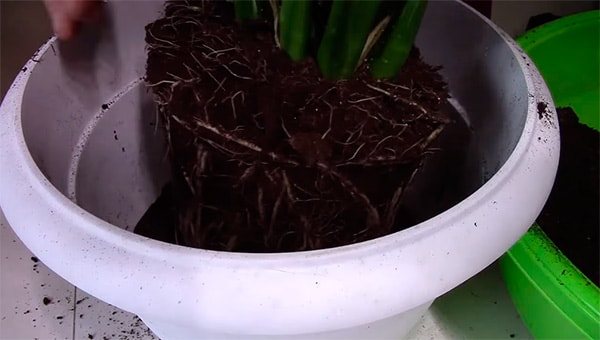

Step 3. Landing:
- on top of the soil, in the center, put an earthen lump and fill the voids with the remaining substrate.
- The soil around the plant is slightly compacted.
- The plant is watered abundantly.
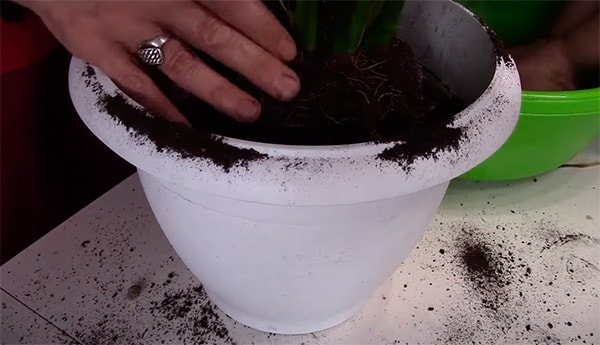

Attention! Often, after watering, the soil settles, exposing the root collar. If this happens, then the soil must be filled up.
With the correct procedure, spathiphyllum will quickly build up the root system.
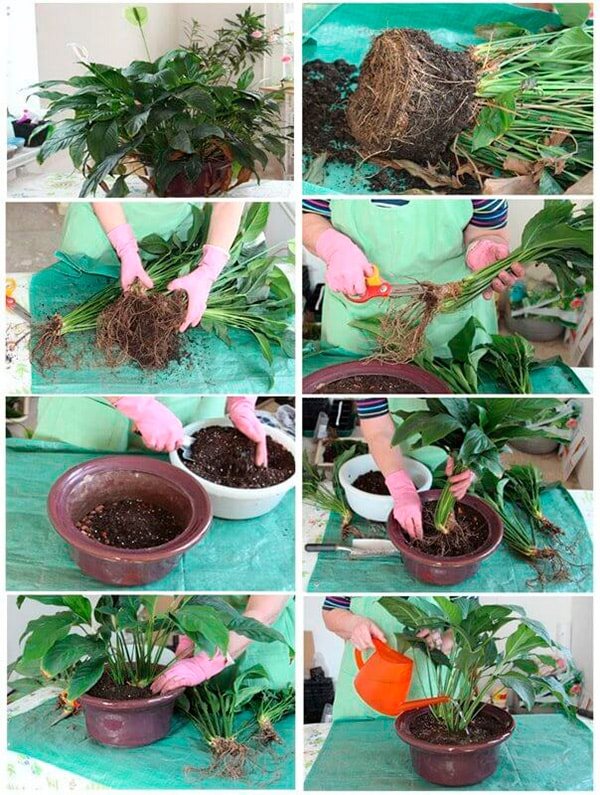

Why there is a need to transplant spathiphyllum
The plant grows well if there is sufficient space for the roots. A spathiphyllum transplant at home is carried out in such cases:
- the bush has just been bought and is in a small pot;
- regularly every 3-5 years in the spring to ensure development, since the bush grows quickly, and the roots intertwine, twine around the entire substrate, stick out to the surface;
- if the lower leaves inside the bush dry up;
- for reproduction, choosing from the bundle a fragment where there is a growth point and roots.
Spathiphyllum - home care, why leaf tips dry
There is another important reason when you need to think about how to transplant spathiphyllum faster: in the absence of flowering.
Additional Information. Transplanting is not necessary if the tops of the leaves turn yellow. This is a sign that the air in the room is too dry for spathiphyllum.
What kind of container is better?
The main difference between a pot and a planter is the presence of an impenetrable bottom at the second. The container with the plant is inserted into the planter, which can be placed anywhere: suspended at a height or placed on a windowsill. It rather plays a decorative role, in contrast to a flowerpot, which has a specific function, but still it has its own advantages:
- The planter can hide any external flaws in the flower pot. For example, ceramic flowerpots build up an ugly white coating on the outside.
- As a rule, trays for draining water under the bottom of the pot have low sides, and if they move awkwardly, they can be dropped and liquid spilled. A cache-pot can not only serve as a decorative role, but also become a pallet, more stable and safe.
- The planter will help keep unstable flowerpots in balance.
- Pebbles or expanded clay can be poured into the remaining space between the pots and the flowerpot, filled with water, which will help to perfectly humidify the air in the room.
- If during the period of use of the pot it loses its attractiveness, you will have to deal with the process of transplanting the spathiphyllum, the pots can simply be replaced without touching the plant itself.
Each grower chooses what he likes. It is more convenient for someone to use flower pots, and for someone to use pots.
How to plant "Women's happiness"
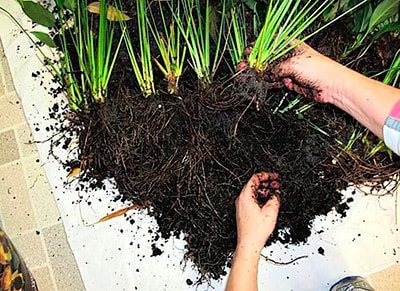

Strongly overgrown spathiphyllum specimens are planted to obtain new plants and in order to rejuvenate the parental form.
The planting technology is quite simple and has a lot in common with the transplant. As in the case of a transplant, it begins with the preparation of the container, the substrate and the plant itself.
- A few hours before planting, the flower is watered abundantly or immersed in a container of water until the soil is completely softened.
- The earthen ball is removed from the pot. The roots are freed from the ground, washed and, after a thorough revision, are divided (cut) into pieces or deboned. Each part must have at least 5 leaves and independent roots.
- Delenki are seated in individual containers filled with fresh soil. The process of planting delenoks is similar to transplanting, but it is performed with a complete replacement of the soil.
Photo
In the photo below you can familiarize yourself with how spathiphyllum looks like and the main points of its transplant.
Frequently asked questions
Can a flowering plant be transplanted?
A flowering plant should not be repotted. It is better to wait for the end of flowering, especially since it is not so long: 2-3 weeks.
However, there are times when a flower needs an urgent transplant: the plant is flooded, suffers from an improperly selected pot, or is damaged by soil pests. In these and similar cases, delay is tantamount to the loss of a flower. Then the risk is justified.
How to transplant blooming spathiphyllum?
It is better to transplant blooming spathiphyllum on a cloudy or rainy day. In conditions of high humidity, the plant will tolerate the procedure more easily.
Before transplanting, all peduncles, as well as old and newly appeared leaves, are cut off from flowering plants at the base.
Healthy specimens are transplanted by the transshipment method, sick ones - with a complete replacement of soil.
Why did a newly transplanted spathiphyllum drop its leaves?
This reaction is typical for a plant suffering from a lack of moisture. Water and spray the leaves of the flower.
Why do the lower leaves of the transplanted spathiphyllum turn yellow?
They were probably forgotten to remove before transplanting. It is hard for the plant and it gets rid of everything unnecessary. If, after the lower ones, young leaves also turned yellow, then this is evidence of a lack of nutrients.
What will not work
In order for the purchase of a container for spathiphyllum to be successful and useful, you should study in detail which vessels are not suitable for it. Among these are:
- Large pots, since it is better to increase the volume of the vessel gradually.
- Wood and glass products. It is more expedient to purchase containers made of ceramic or plastic.
- Dark and transparent flowerpots - the roots in them often overheat.
- Deep vessels, considering the growth of the roots to the sides, not down.
Read also: Smoking tobacco growing care collecting storage use
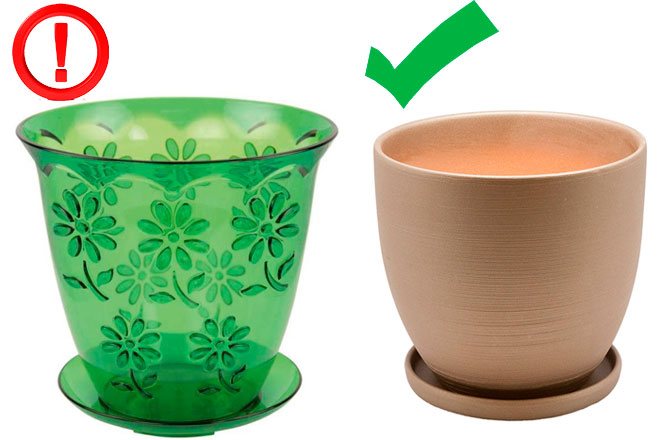

If you ignore these recommendations and choose an unsuitable pot for planting or transplanting, then the following problems will await plant growing enthusiasts:
- the stems of an exotic culture will begin to lose their turgor;
- leaf plates will turn yellow, dry;
- due to a lack of moisture and nutrients, plants will grow poorly, develop, dry out (a similar effect is observed when using a very narrow pot);
- lack of flowering;
- drooping leaves.
To prevent the appearance of such negative consequences, it is recommended to take into account all the features of the spathiphyllum and not to acquire excessively narrow or too wide flowerpots.In addition, it is better to give preference to natural materials in which the plant will feel quite comfortable. A properly selected pot guarantees spathiphyllum a long life with luxurious flowering.
Spathiphyllum is a plant that came to us from South America. It grows actively in swampy areas and "loves" a humid climate. Indoor spathiphyllum is a beautiful indoor plant that draws a lot of attention to itself. Among the people, it is called nothing less than "female happiness" and can have a variety of sizes. There are both giant plants and charming dwarfs. For spathiphyllum, it is very important to choose the right pot correctly. Today we will talk about which options are most suitable for this.
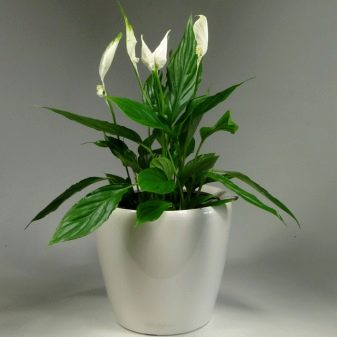

Varieties of spathiphyllum
Houses are trying to grow the most unpretentious varieties of spathiphyllum. Many naturally occurring plant species are adapted for growing in apartments, improved by breeders. Here are some popular varieties.
- Wallis's spathiphyllum. Served as the basis for the creation of most modern varieties. The bush reaches 45 cm, the inflorescence is up to 10 cm. It is considered the most unpretentious of all existing species.
- Spathiphyllum Domino. Differs in high decorativeness not only of flowers, but also of leaves. They are neat, oblong in shape, with a sharp tip. The variety got its name because of its unusual color - randomly scattered light strokes and stripes on a dark green background. The dignity of the variety is long flowering.
- Spathiphyllum Chopin. A small bush no more than 40 cm tall. The leaves are neat, oblong, the veins are pronounced. The variety was bred by breeders. Differs in an unobtrusive, but pleasant aroma.
- Spathiphyllum Sensation. Tall hybrid. With good care, it reaches one and a half meters in height. Inflorescences are large, expressive.
- Spathiphyllum Strauss. An interesting undersized variety no more than 30 cm in height. The leaves are elongated, leathery, dark green.
- Spathiphyllum is abundantly flowering. A popular variety with a long flowering period. The inflorescences are medium in size, the leaves are oval, darkening as they mature. The peduncle is long.
How to properly prepare a bush?
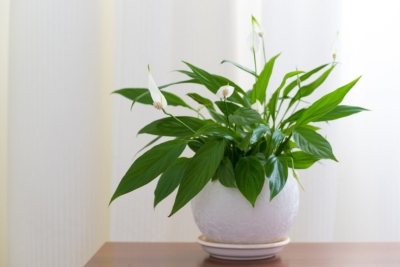

Proper preparation of your plant for transplantation is the key to its healthy existence in the future.
For to transplant spathiphyllum into another container, you should first:
- Prepare the soil by thoroughly wetting it with water for better lifting of the plant.
- As for the flower itself, it must be removed from the pot with a garden scoop, without touching the roots.
- After removing from the pot, the rhizome itself must be thoroughly cleaned of drainage and soil residues.
- If you notice flower stalks on the spathiphyllum, then cut them off so that the plant does not waste extra energy on them.
An important aspect is that the plant must be healthy for the transplanting process. That is why, before transplanting, pay attention to the external state of the flower.
What do you need to prepare in advance?
It is advisable to stock up on all the necessary equipment in advance. It is necessary to prepare a small pot with a large diameter, which must be thoroughly washed and rinsed with boiling water for disinfection. You will also need pruning shears, duck and rubber gloves (optional).
screenshot_11.jpg
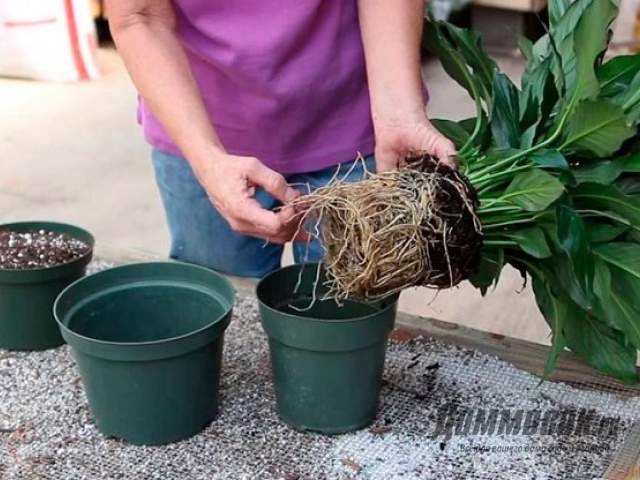

For good health, spathiphyllum needs a loose, slightly acidic earth. When buying ready-made soil, you should give preference to a universal soil mixture for aroid or tropical plants, sand must be mixed in. Self-cooking is also not a difficult procedure. It is necessary to combine a portion of leafy earth with two parts of sod, add a portion of peat and one part of sand. The addition of charcoal will enhance the antibacterial properties of the mixture, and brick chips will create drainage. Superphosphate will enrich the soil with minerals.
screenshot_10.jpg
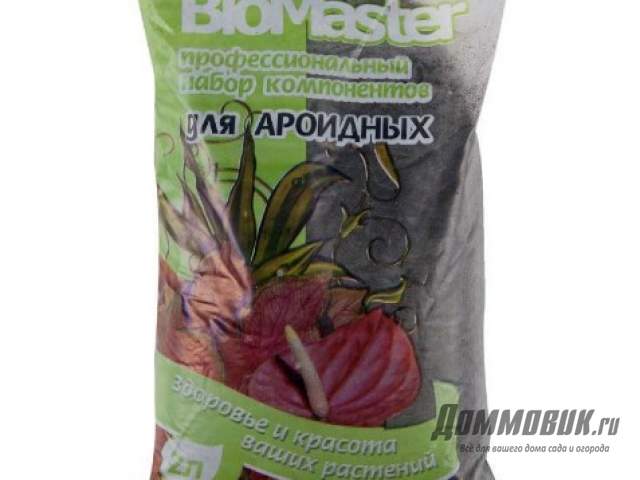

Reproduction methods
Propagated by dividing the bush, seeds and apical cuttings. Sowing with seeds is used in rare cases - to grow a new variety. There is no need to use cuttings. The plant produces many babies.
When children appear, the bush is divided into several parts. They make sure that roots and a growth point remain on each. In the absence of roots, the young plant is planted in wet sand for rooting. Small pots are used - about 9 cm.
Important! Sometimes the plant does not bloom for a long time. Why does spathiphyllum not bloom? Perhaps the plant is too young - flowers appear when it reaches maturity. The first flowering begins when the root system completely fills the pot. In adult plants, the lack of flowering is associated with low temperatures, insufficient moisture, and poor soil.
What won't work?
Before you go to the store to buy a pot for spathiphyllum, you need to figure out which containers are not suitable for this.
These options include:
- large pots (the size of the container must be increased gradually with each transplant);
- a flowerpot made of wood or glass (in such containers you cannot expect good development of the root system, it is better to use a model made of ceramics or plastic);
- a transparent pot or a dark container that is subject to overheating in the sun is undesirable;
- deep pot (the roots of the spathiphyllum do not grow down, but to the sides).
The selection of a pot for spathiphyllum should be approached thoroughly. If you buy an unsuitable copy, then this can entail the occurrence of various problems. Let's get acquainted with them.
- Loss of plant turgor is possible.
- Spathiphyllum leaves may turn yellow and dry.
- In a flowerpot of an unsuitable size, the root system of the plant will receive less moisture and minerals, which is why it will begin to hurt and dry out. The purchase of both too large and too narrow containers can lead to a similar effect.
- In an incorrectly selected flowerpot, the exotic may stop blooming, and its leaves may fall.
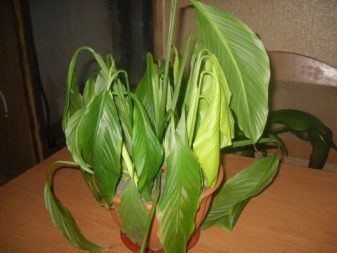

In order not to face the listed problems, it is very important to choose a good pot of the optimal size. It shouldn't be too narrow or wide. The material from which it is made must be environmentally friendly, safe and not subject to hypothermia or overheating. Only if these rules are observed can a healthy and lush spathiphyllum be grown, which will become a spectacular interior decoration.
For information on how to transplant spathiphyllum, see the next video.
If you want to get a houseplant, you can recommend spathiphyllum or "female happiness". It fascinates with its beauty, tenderness, and during flowering - incomparable! When creating flower arrangements, for example, a small green island, one of the main roles is assigned to it.
An experienced person knows all the subtleties of the question of how to plant and transplant spathiphyllum, he does not see any difficulties in this. But that amateur florist who first brought a plant into the house needs advice, including how to choose a pot for spathiphyllum. Since this new "inhabitant" of the house is not a whimsical plant to care for, it will not be a problem to choose which pot to plant it in.
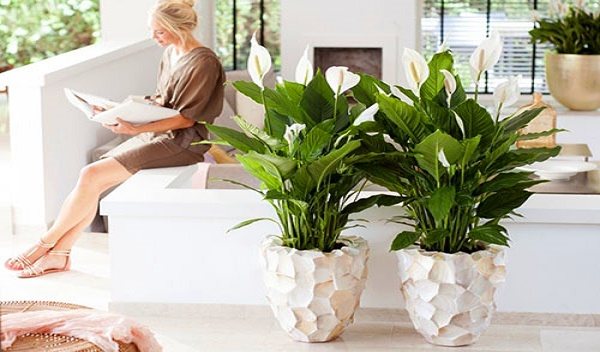

The importance of making the right choice
As mentioned above, it is very important for spathiphyllum to choose the right pot. Only under this condition can we talk about the longevity and health of this indoor plant. As practice shows, spathiphyllum feels great in a high-quality flowerpot. This plant is not moody. However, there are a number of important factors to consider when choosing the right pot:
- the material from which the pot is made;
- its size;
- the form;
- colors.
Each of these points plays an important role in choosing a good pot. The development of the flower will directly depend on these parameters.It is necessary to select such vessels in which the root system of the plant will not be exposed to overheating or hypothermia. In addition, the presence of special drainage holes in the pot plays an important role. If they are not there, then a destructive stagnation of moisture is possible in the container, because of which the roots can simply begin to rot and the flower will soon die. That is why choosing the right flowerpot is so important.
Flowering period
Can blooming spathiphyllum be transplanted? There is a simple answer to this question - you shouldn't. This will be explained by the fact that during the flowering period, the plant puts all its energy into the development of the flower, and after transplantation, the plant will simply weaken and may not take root. Also, transplanting can negatively say on the state of the flowers that appear.
The plant also cannot be transplanted several times in a row, since frequent processes can lead to the wilting of the flower, which in the future can affect its health.
Folk omens and superstitions
At all times, they tried to present women and girls with a gift in the form of a spathiphyllum flower. It is believed that the presented flower "Women's happiness" is able to fill the house with harmony and awaken the sleeping feelings of love. This simple houseplant is endowed with magical powers, but, according to legend, it can only make women happy:
- Unmarried girls are given the opportunity to meet their betrothed and get married.
- Married women - to achieve harmony in marital relationships.
- Women without children - to find the joy of motherhood.
It is believed that in the house where the flower blossomed, family life begins to improve, disputes and disagreements, irritations and misunderstandings between family members go away. The soul, as it were, becomes free from the accumulated grievances and disappointments. Firm faith in oneself and in one's own strength is returning. In order for the energy of this flower to be able to perform a miracle, the most important thing is to believe in it. For all of the above, it is necessary to create favorable conditions for the plant for its normal growth and development.
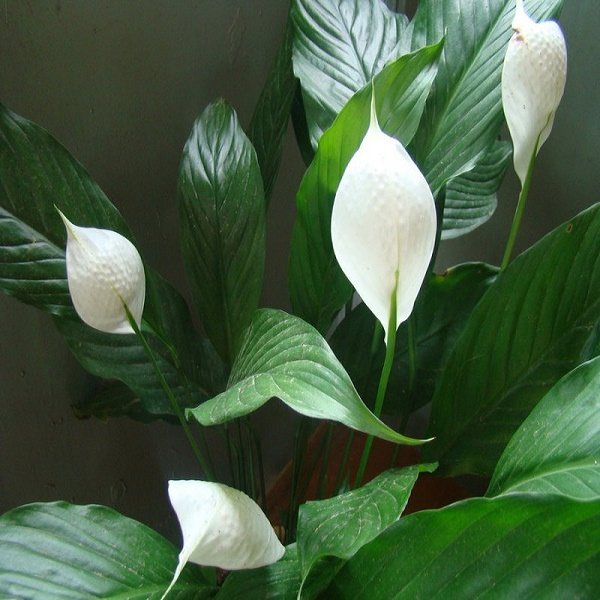

Description and general information
Spathiphyllum, or Spathiphyllum (Latin Spathiphyllum) belongs to the Aroid family. The natural growing environment is a tropical climate. Distributed in East Asia and America. About 40 species are known. As a houseplant, spathiphyllum is distinguished by a variety of varieties and colors. Evergreen herbaceous perennial, average height up to 30 cm. There are tall and dwarf varieties.
The plant does not have a stem, a bunch of leaves grows directly from the ground. Leaves are dark green, oblong-lanceolate. Spathfullum flowers look original - ears on long peduncles of cream or pale pink color. The flower is surrounded by a white veil, which gradually turns green. The shape of the coverlet is compared to a flag waving in the wind. For this, the people often call him a flag-leaf.
Inexperienced amateur flower growers sometimes face a lack of flowering. Achieve it with enhanced care, compliance with all growing rules. Blooms from spring to mid-summer. Sometimes it blooms again in autumn.
Interesting! All types of spathiphyllum are popularly known under the name "female happiness". It is believed to banish loneliness from home. It helps single girls find a betrothed, family girls - to establish relationships with a second half, childless - to have children.
How to transplant into another pot
There are no tricks here either:
- A prepared moist substrate is poured over the drainage laid in the container.
- A small depression is made in the middle of the pot.
- A leg with neatly divorced roots is placed in it.
- The hole is immediately covered with a new portion of soil, not forgetting to crush the soil near the trunk (until its level reaches the leaves).
- Immediately after transplanting, abundant watering follows. Prepare for the soil to settle slightly, and the substrate will have to be poured.This is an important point - if left out, the plant can wobble in the pot.
- Finally, be sure to spray the leaves.
For better acceptance in a new place, the plant needs to create special conditions for a short time.
Spathiphyllum, or female happiness - what is this flower
Spathiphyllum is a tropical flower native to South America. It has no stem, oval leaves grow directly from the soil. The inflorescence is a small white sailboat with a long thin stem. This flower is a heat-loving plant, and therefore caring for it is quite difficult. It is required to monitor not only the air temperature in the room, but also the drafts.
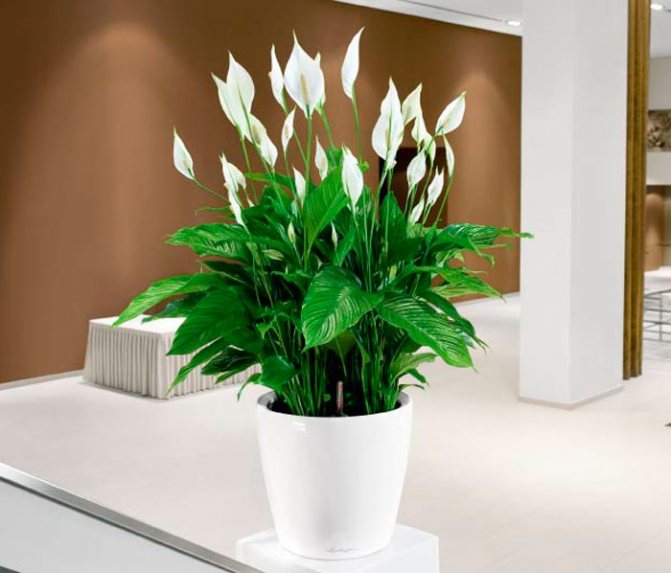

Spathiphyllum
Women's happiness has magical powers: it helps girls meet the chosen one, find a husband and children. However, in order for all this to come true, it is required to communicate with the color and carefully care for it.
Purchase rules
How many useful things are in one plant! To make at least one desire come true, you can try to get this magical flower. Of course, it will be nice if someone comes up with a gift, but if this does not happen, you should purchase "Women's Happiness" yourself. In this case, it is imperative to adhere to some not tricky rules:
- It is better to make a purchase on Wednesday, Friday or Saturday, according to the magical canon, they are considered women's days.
- It is imperative that the saleswoman be a woman with blonde hair and eyes.
- When paying for the goods, give more money than the real price, while leaving the change with the seller. Otherwise, no magic happens.
Let happiness, simple joys of life and health not pass by. Let spathiphyllum or "Women's happiness" bring joy to the soul!
The importance of making the right choice
For planting female happiness, as spathiphyllum is also called, it is very important to choose a high-quality flowerpot. Despite the fact that an exotic culture does not belong to capricious plants, you should still choose a pot taking into account:
- material;
- sizes;
- forms;
- color gamut of capacity.
Each parameter from the list directly affects the growth and development of a flower culture. It is advisable to give preference to containers in which the root system will not overheat or overcool. In order to prevent stagnation of moisture, provoking the appearance of rot of the roots of the spathiphyllum, the pot must have drainage holes. The correct approach to the choice is the key to the longevity of female happiness.
